Paul van Yperen's Blog, page 318
February 12, 2017
Hardy Krüger Jr.
German actor Hardy Krüger Jr. (1968) has proved to be more than the son of. He appeared in several international films and starred in popular TV series. Beside his acting career, he is a passionate ambassador for charity.

German postcard by Studio Lemm. Photo: Bavaria Film / Studio Lemm. Publicity still for the TV series Gegen den Wind/Against the Wind (1995-1999).

German autograph card.
Tragicomix
Hardy Krüger Jr. was born in 1968, Lugano, Switzerland. He is the son of the German actor-writer Hardy Krüger and the Italian painter Francesca Marazzi. His half-sister is actress Christiane Krüger.
Shortly after his birth, his father took his wife and son to live on a farm in Tanzania. It had served as the set for the film Hatari! (Howard Hawks, 1962), in which Krüger senior had co-starred with John Wayne.
Krüger junior attended an international school in Germany and then trained and worked as a bartender and cook. In 1989 he took acting classes at the Lee Strasberg School of Acting in Los Angeles and acted in American television shows.
After graduating in 1991 he began his career in Germany with a part in the TV series Nicht von schlechten Eltern/Not bad (1992-1996). He had his breakthrough with the lead role in the TV series Gegen den Wind/Against the Wind (1994-1997).
In the cinema, Krüger appeared in several international productions such as the French films Le Cocu magnifique/The Magnificent Cuckold (Pierre Boutron, 1999) and Astérix & Obélix contre César/Asterix & Obelix Take On Caesar (Claude Zidi, 1999), starring Christian Clavier and Gérard Dépardieu . In the latter Krüger played the bard Tragicomix.

German postcard by ARD / Studio Lemm / Natzeck Design. Photo: publicity still for the TV series Gegen den Wind/Against the Wind (1995-1999) with Hardy Krüger Junior as Sven Westermann.

German autograph card.
Dracula
Hardy Krüger Jr. starred opposite Harald Leipnitz in the German Science Fiction film Vortex (Michael Pohl, 2001) and played Jonathan Harker in the Italian TV mini-series Dracula (Roger Young, 2001), starring Patrick Bergin.
He appeared opposite Sophie Marceau and Vincent Perez in the French comedy Je reste!/3 Is a Crowd (Diane Kurys, 2003). Krüger then starred opposite Sebastian Koch in Stauffenberg/Operation Valkyrie (Jo Baier, 2004), about Claus Schenk Graf von Stauffenberg and the 20 July 1944 plot to assassinate Adolf Hitler. The German-Austrian TV film was awarded the Deutscher Fernsehpreis (German Television Award) for Best Film.
In 2004 and 2006, Krüger won two prestigious German theatre awards for his outstanding performances in the plays Butterflies are free and Visiting Mr. Green.
In 2006, he first appeared as the replacement for Christian Wolff in the popular German TV series Forsthaus Falkenau (2006-2012), in which he played the lead role of the forester Stefan Leitner. Krüger is a UNICEF ambassador against child prostitution. He served as the patron of the charity TukTuk-Tour, a goodwill tour from Asia to Europe, and is involved in a variety of other charity projects.
His first marriage to Petra Zinata in 1991 produced two sons, Daniel Leon (1994) and Noah Ben (1999), and ended in divorce in 2004. In 2009 he remarried to Austrian communications-trainer and painter Katrin Fehringer, with whom he has a daughter, Layla-Katharina (2012) and adopted Vinas (2007), a girl from Thailand. In 2011 they lost their 8-months-old son Paul Luca. The couple divorced in 2015.
Recently Hardy Krüger Junior starred in the TV crime series Notruf Hafenkante/Hamburg Dockland (2015-2016).
German trailer for Die Schokoladenkönigin. Source: Matthiaskopptv (YouTube).
German trailer for Auch Erben will gelernt sein. Source: Polar Film (YouTube).
Sources: Hardykruegerjr.de, Wikipedia (German and English) and .

German postcard by Studio Lemm. Photo: Bavaria Film / Studio Lemm. Publicity still for the TV series Gegen den Wind/Against the Wind (1995-1999).

German autograph card.
Tragicomix
Hardy Krüger Jr. was born in 1968, Lugano, Switzerland. He is the son of the German actor-writer Hardy Krüger and the Italian painter Francesca Marazzi. His half-sister is actress Christiane Krüger.
Shortly after his birth, his father took his wife and son to live on a farm in Tanzania. It had served as the set for the film Hatari! (Howard Hawks, 1962), in which Krüger senior had co-starred with John Wayne.
Krüger junior attended an international school in Germany and then trained and worked as a bartender and cook. In 1989 he took acting classes at the Lee Strasberg School of Acting in Los Angeles and acted in American television shows.
After graduating in 1991 he began his career in Germany with a part in the TV series Nicht von schlechten Eltern/Not bad (1992-1996). He had his breakthrough with the lead role in the TV series Gegen den Wind/Against the Wind (1994-1997).
In the cinema, Krüger appeared in several international productions such as the French films Le Cocu magnifique/The Magnificent Cuckold (Pierre Boutron, 1999) and Astérix & Obélix contre César/Asterix & Obelix Take On Caesar (Claude Zidi, 1999), starring Christian Clavier and Gérard Dépardieu . In the latter Krüger played the bard Tragicomix.

German postcard by ARD / Studio Lemm / Natzeck Design. Photo: publicity still for the TV series Gegen den Wind/Against the Wind (1995-1999) with Hardy Krüger Junior as Sven Westermann.

German autograph card.
Dracula
Hardy Krüger Jr. starred opposite Harald Leipnitz in the German Science Fiction film Vortex (Michael Pohl, 2001) and played Jonathan Harker in the Italian TV mini-series Dracula (Roger Young, 2001), starring Patrick Bergin.
He appeared opposite Sophie Marceau and Vincent Perez in the French comedy Je reste!/3 Is a Crowd (Diane Kurys, 2003). Krüger then starred opposite Sebastian Koch in Stauffenberg/Operation Valkyrie (Jo Baier, 2004), about Claus Schenk Graf von Stauffenberg and the 20 July 1944 plot to assassinate Adolf Hitler. The German-Austrian TV film was awarded the Deutscher Fernsehpreis (German Television Award) for Best Film.
In 2004 and 2006, Krüger won two prestigious German theatre awards for his outstanding performances in the plays Butterflies are free and Visiting Mr. Green.
In 2006, he first appeared as the replacement for Christian Wolff in the popular German TV series Forsthaus Falkenau (2006-2012), in which he played the lead role of the forester Stefan Leitner. Krüger is a UNICEF ambassador against child prostitution. He served as the patron of the charity TukTuk-Tour, a goodwill tour from Asia to Europe, and is involved in a variety of other charity projects.
His first marriage to Petra Zinata in 1991 produced two sons, Daniel Leon (1994) and Noah Ben (1999), and ended in divorce in 2004. In 2009 he remarried to Austrian communications-trainer and painter Katrin Fehringer, with whom he has a daughter, Layla-Katharina (2012) and adopted Vinas (2007), a girl from Thailand. In 2011 they lost their 8-months-old son Paul Luca. The couple divorced in 2015.
Recently Hardy Krüger Junior starred in the TV crime series Notruf Hafenkante/Hamburg Dockland (2015-2016).
German trailer for Die Schokoladenkönigin. Source: Matthiaskopptv (YouTube).
German trailer for Auch Erben will gelernt sein. Source: Polar Film (YouTube).
Sources: Hardykruegerjr.de, Wikipedia (German and English) and .
Published on February 12, 2017 22:00
February 11, 2017
Exported to the USA: Alla Nazimova
Alla Nazimova (1879–1945) was a grand, highly flamboyant star of the American silent cinema. The Russian-born film and theatre actress, screenwriter, and film producer was widely known as just Nazimova. On Broadway, she was noted for her work in the classic plays of Ibsen, Chekhov and Turgenev. Her efforts at silent film production were less successful, but a few sound-film performances survive as a record of her art.
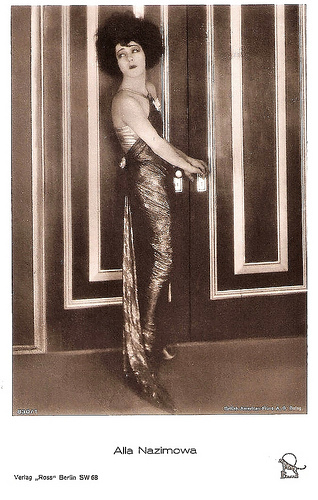
German postcard by Ross Verlag, no. 830/1, 1925-1926. Photo: British-American Films A.G. Balag. Publicity still for Camille (Ray C. Smallwood, 1921).
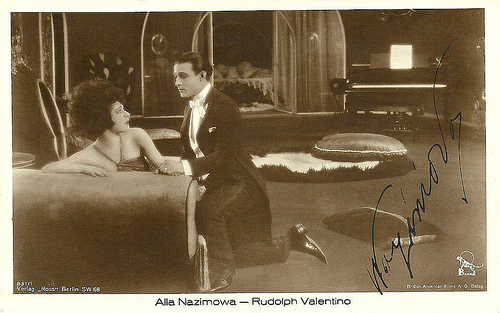
German postcard by Ross Verlag, no. 831/1, 1925-1926. Photo: British American Films / Balag. Collection: Didier Hanson. Publicity still for Camille (Ray C. Smallwood, 1921) with Rudolph Valentino.
Stanislavski
Alla Nazimova (Russian: Алла Назимовa) was born Marem-Ides Leventon (Russian name Adelaida Yakovlevna Leventon) in Yalta, Crimea, Russian Empire, in 1879. She was the youngest of three children of Jewish parents Yakov Abramovich Leventon, a pharmacist, and Sofia (Sara) Lvovna Horowitz, who moved to Yalta in 1870 from Kishinev.
At age 17 Alla Leventon abandoned her training as a violinist and went to Moscow to work in theatre with V.I. Nemirovich-Danchenko. In 1892, she joined Constantin Stanislavski's Moscow Art Theatre using the name of Alla Nazimova for the first time. Her stage name was a combination of Alla (a diminutive of Adelaida) and the surname of Nadezhda Nazimova, the heroine of the Russian novel Children of the Streets.
Nazimova's theatre career blossomed early. In 1899 she married Sergei Golovin, a fellow actor, but they soon separated. Gary Brumburgh at IMDb : “She grew discontented with Stanislavsky and later performed in repertory. She met the legendary Pavel Orlenev, a close friend of Anton Chekhov and Maxim Gorky, and entered into both a personal and professional relationship with him.”
By 1903 she was a major star in Moscow and Saint Petersburg. She toured Europe, including London and Berlin, with Orlenev. They immigrated to the United States in 1905. He soon returned, but she was signed up by the American producer Henry Miller. Although she spoke not a word of English, she so impressed the Shubert brothers that they hired her on the condition she learn English in six months.
In 1906 she made her Broadway debut in the title role of Hedda Gabler by Henrik Ibsen to critical and popular success. She also played other Ibsen characters: Nora in A Doll’s House, Hedwig in The Wild Duck, and Hilda in The Master Builder. She quickly became extremely popular and remained a major Broadway star for years.
From 1912 to 1925 Nazimova maintained a ‘fake marriage’ with British actor and director Charles Bryant, who was often her co-star. In order to bolster this arrangement with Bryant, Nazimova kept her marriage to Golovin secret.
Due to her notoriety in a 35-minute 1915 pacifist play entitled War Brides, Nazimova made her silent film debut in the film version, War Brides (Herbert Brenon, 1916), which was produced by independent producer Lewis J. Selznick. She made $100,000 touring in War Brides and an additional $60,000 for the film version. The film's lost status makes it now a sought-after title.
In 1917, she negotiated a contract with Metro Pictures, a precursor to MGM, that included a weekly salary of $13,000. She moved from New York to Hollywood, where she made a number of highly successful films for Metro, including a part as a reformed prostitute in Revelation (George D. Baker, 1918), that earned her a considerable amount of money.
Nazimova soon felt confident enough in her abilities to begin producing and writing films in which she also starred. Examples are Eye for Eye (Albert Capellani, 1918), The Brat (Herbert Blache, 1919) and Madame Peacock (Ray C. Smallwood, 1920).
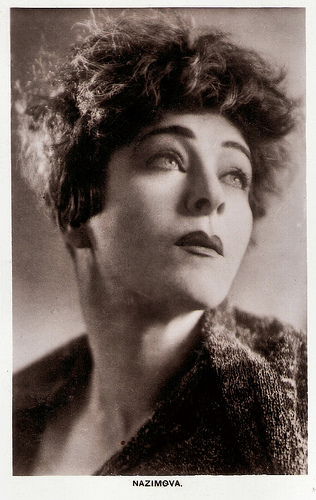
British postcard in the Picturegoer series, London, no. 203
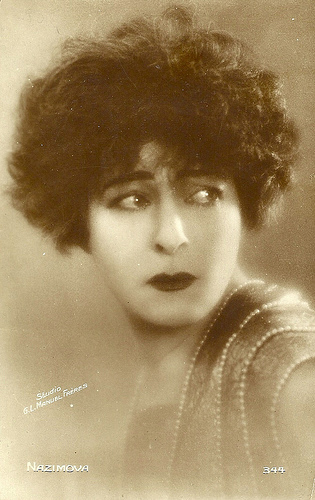
French postcard, no. 344. Photo: Studio G.L. Manuel Frères. Collection: Didier Hanson.
Lavish Art Deco sets
Alla Nazimova starred in Camille (Ray C. Smallwood, 1921) as the courtesan Marguerite opposite Rudolph Valentino as her idealistic young lover Armand. Camille is based on the play adaptation La Dame aux Camélias (The Lady of the Camellias) by Alexandre Dumas, fils.
The film was set in 1920s Paris, whereas the original version took place in Paris in the 1840s. It had lavish Art Deco sets and Rudolph Valentino later married the art director, Natacha Rambova. Jennifer Horne at The Women Film Pioneers Project : “Working under contract with Metro Pictures Corporation between late 1917 and April 1921, her company, Nazimova Productions, produced nine largely profitable, feature-length films and brought along the writing talent of writer-producer June Mathis. Details regarding the supervisory roles Nazimova played in the production of many of her films remain confusing since not all of Nazimova’s contributions are reflected in the official credits on films.”
In her film adaptations A Doll's House (Charles Bryant, 1922), based on Henrik Ibsen, and Salomé (Charles Bryant, 1923), based on Oscar Wilde's play, Nazimova developed her own film making techniques, which were considered daring at the time.
Despite the film being only a little over an hour in length and having no real action to speak of, Salomé cost over $350,000 to make. All the sets were constructed indoors to be able to have complete control over the lighting. The film was shot completely in black and white, matching the illustrations done by Aubrey Beardsley in the printed edition of Wilde's play. The costumes, designed by Natacha Rambova, used material only from Maison Lewis of Paris, such as the real silver lamé loincloths worn by the guards.
Both A Doll's House and Salomé were critical and commercial failures. Gary Brumburgh: “The monetary losses she suffered as producer were astronomical. The Hays Code, which led to severe censorship in pictures, also led to her downfall, as did her outmoded acting style.”
By 1925 Nazimova could no longer afford to invest in more films; and financial backers withdrew their support. Left with few options, she gave up on the film industry. She became an American citizen in 1927.
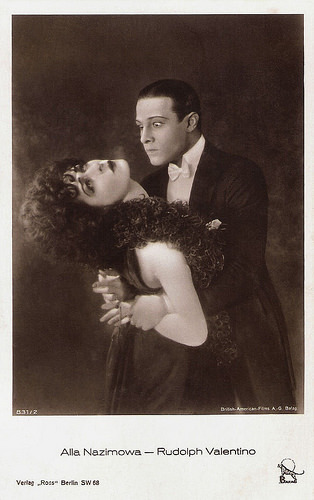
German postcard by Ross Verlag, Berlin, no. 831/2, 1925-1926. Photo: British-American-Films A.G. (Balag). Publicity still for Camille (Ray C. Smallwood, 1921) with Rudolph Valentino

Danish postcard by Stenders Kunstforlag, no. 39. Photo: First National Pictures. Publicity still for Madonna of the Streets (Edwin Carewe, 1924) with Milton Sills.
Outlandish parties at her mansion on Sunset Boulevard
In 1928, Alla Nazimova returned to the Broadway stage as Madame Ranevsky in Eva Le Gallienne’s production of Anton Chekhov’s The Cherry Orchard.
Acclaimed were also her starring roles as Natalya Petrovna in Rouben Mamoulian's 1930 production of Turgenev's A Month in the Country, Christine in Eugene O’Neill’s Mourning Becomes Electra (1931), O-Lan in Pearl Buck’s The Good Earth (1932), and as Mrs. Alving in Ibsen's Ghosts (1935).
In the early 1940s, she played character roles in a few more films. She played Robert Taylor's mother who is in a concentration camp in Nazi Germany in Escape (Mervyn Le Roy, 1940) and Tyrone Power's mother in Blood and Sand (Rouben Mamoulian, 1941). Her final film was Since You Went Away (John Cromwell, 1944), an epic about the American home front during World War II.
Nazimova openly conducted relationships with women, and there were outlandish parties at her mansion on Sunset Boulevard, in Hollywood, California, known as ‘The Garden of Alla’. She is credited with having originated the phrase ‘sewing circle’ as a discreet code for lesbian or bisexual actresses.
Nazimova helped start the careers of both of Rudolph Valentino's wives, Jean Acker and Natacha Rambova. Although she was involved in a lesbian affair with Acker, it is debated if Nazimova and Rambova had a sexual affair. Nazimova was impressed by Rambova's skills as an art director, and Rambova designed the innovative sets for Nazimova's film productions of Camille and Salomé.
Of those Nazimova is confirmed to have been involved with romantically, the list includes actress Eva Le Gallienne, director Dorothy Arzner, writer Mercedes de Acosta, and Oscar Wilde's niece, Dolly Wilde. Nazimova lived with Glesca Marshall from 1929 until her death.
In 1945 Alla Nazimova died of a coronary thrombosis in a hospital in Los Angeles. She was 66.
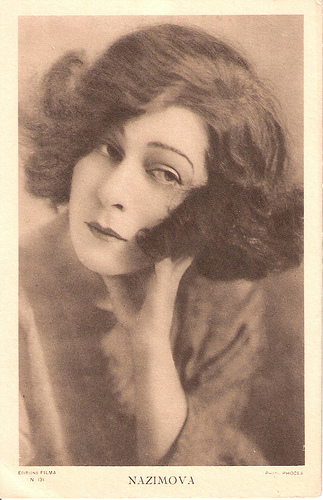
French postcard by Editions Filma, no. 131. Photo: Phocea was a French distributor in the early 1920s, that apparently distributed films with Nazimova in France then.
Sources: Jennifer Horne (Women Film Pioneers Project), (IMDb), Sandra Brennan (AllMovie), Encyclopaedia Britannica, Wikipedia and .

German postcard by Ross Verlag, no. 830/1, 1925-1926. Photo: British-American Films A.G. Balag. Publicity still for Camille (Ray C. Smallwood, 1921).

German postcard by Ross Verlag, no. 831/1, 1925-1926. Photo: British American Films / Balag. Collection: Didier Hanson. Publicity still for Camille (Ray C. Smallwood, 1921) with Rudolph Valentino.
Stanislavski
Alla Nazimova (Russian: Алла Назимовa) was born Marem-Ides Leventon (Russian name Adelaida Yakovlevna Leventon) in Yalta, Crimea, Russian Empire, in 1879. She was the youngest of three children of Jewish parents Yakov Abramovich Leventon, a pharmacist, and Sofia (Sara) Lvovna Horowitz, who moved to Yalta in 1870 from Kishinev.
At age 17 Alla Leventon abandoned her training as a violinist and went to Moscow to work in theatre with V.I. Nemirovich-Danchenko. In 1892, she joined Constantin Stanislavski's Moscow Art Theatre using the name of Alla Nazimova for the first time. Her stage name was a combination of Alla (a diminutive of Adelaida) and the surname of Nadezhda Nazimova, the heroine of the Russian novel Children of the Streets.
Nazimova's theatre career blossomed early. In 1899 she married Sergei Golovin, a fellow actor, but they soon separated. Gary Brumburgh at IMDb : “She grew discontented with Stanislavsky and later performed in repertory. She met the legendary Pavel Orlenev, a close friend of Anton Chekhov and Maxim Gorky, and entered into both a personal and professional relationship with him.”
By 1903 she was a major star in Moscow and Saint Petersburg. She toured Europe, including London and Berlin, with Orlenev. They immigrated to the United States in 1905. He soon returned, but she was signed up by the American producer Henry Miller. Although she spoke not a word of English, she so impressed the Shubert brothers that they hired her on the condition she learn English in six months.
In 1906 she made her Broadway debut in the title role of Hedda Gabler by Henrik Ibsen to critical and popular success. She also played other Ibsen characters: Nora in A Doll’s House, Hedwig in The Wild Duck, and Hilda in The Master Builder. She quickly became extremely popular and remained a major Broadway star for years.
From 1912 to 1925 Nazimova maintained a ‘fake marriage’ with British actor and director Charles Bryant, who was often her co-star. In order to bolster this arrangement with Bryant, Nazimova kept her marriage to Golovin secret.
Due to her notoriety in a 35-minute 1915 pacifist play entitled War Brides, Nazimova made her silent film debut in the film version, War Brides (Herbert Brenon, 1916), which was produced by independent producer Lewis J. Selznick. She made $100,000 touring in War Brides and an additional $60,000 for the film version. The film's lost status makes it now a sought-after title.
In 1917, she negotiated a contract with Metro Pictures, a precursor to MGM, that included a weekly salary of $13,000. She moved from New York to Hollywood, where she made a number of highly successful films for Metro, including a part as a reformed prostitute in Revelation (George D. Baker, 1918), that earned her a considerable amount of money.
Nazimova soon felt confident enough in her abilities to begin producing and writing films in which she also starred. Examples are Eye for Eye (Albert Capellani, 1918), The Brat (Herbert Blache, 1919) and Madame Peacock (Ray C. Smallwood, 1920).

British postcard in the Picturegoer series, London, no. 203

French postcard, no. 344. Photo: Studio G.L. Manuel Frères. Collection: Didier Hanson.
Lavish Art Deco sets
Alla Nazimova starred in Camille (Ray C. Smallwood, 1921) as the courtesan Marguerite opposite Rudolph Valentino as her idealistic young lover Armand. Camille is based on the play adaptation La Dame aux Camélias (The Lady of the Camellias) by Alexandre Dumas, fils.
The film was set in 1920s Paris, whereas the original version took place in Paris in the 1840s. It had lavish Art Deco sets and Rudolph Valentino later married the art director, Natacha Rambova. Jennifer Horne at The Women Film Pioneers Project : “Working under contract with Metro Pictures Corporation between late 1917 and April 1921, her company, Nazimova Productions, produced nine largely profitable, feature-length films and brought along the writing talent of writer-producer June Mathis. Details regarding the supervisory roles Nazimova played in the production of many of her films remain confusing since not all of Nazimova’s contributions are reflected in the official credits on films.”
In her film adaptations A Doll's House (Charles Bryant, 1922), based on Henrik Ibsen, and Salomé (Charles Bryant, 1923), based on Oscar Wilde's play, Nazimova developed her own film making techniques, which were considered daring at the time.
Despite the film being only a little over an hour in length and having no real action to speak of, Salomé cost over $350,000 to make. All the sets were constructed indoors to be able to have complete control over the lighting. The film was shot completely in black and white, matching the illustrations done by Aubrey Beardsley in the printed edition of Wilde's play. The costumes, designed by Natacha Rambova, used material only from Maison Lewis of Paris, such as the real silver lamé loincloths worn by the guards.
Both A Doll's House and Salomé were critical and commercial failures. Gary Brumburgh: “The monetary losses she suffered as producer were astronomical. The Hays Code, which led to severe censorship in pictures, also led to her downfall, as did her outmoded acting style.”
By 1925 Nazimova could no longer afford to invest in more films; and financial backers withdrew their support. Left with few options, she gave up on the film industry. She became an American citizen in 1927.

German postcard by Ross Verlag, Berlin, no. 831/2, 1925-1926. Photo: British-American-Films A.G. (Balag). Publicity still for Camille (Ray C. Smallwood, 1921) with Rudolph Valentino

Danish postcard by Stenders Kunstforlag, no. 39. Photo: First National Pictures. Publicity still for Madonna of the Streets (Edwin Carewe, 1924) with Milton Sills.
Outlandish parties at her mansion on Sunset Boulevard
In 1928, Alla Nazimova returned to the Broadway stage as Madame Ranevsky in Eva Le Gallienne’s production of Anton Chekhov’s The Cherry Orchard.
Acclaimed were also her starring roles as Natalya Petrovna in Rouben Mamoulian's 1930 production of Turgenev's A Month in the Country, Christine in Eugene O’Neill’s Mourning Becomes Electra (1931), O-Lan in Pearl Buck’s The Good Earth (1932), and as Mrs. Alving in Ibsen's Ghosts (1935).
In the early 1940s, she played character roles in a few more films. She played Robert Taylor's mother who is in a concentration camp in Nazi Germany in Escape (Mervyn Le Roy, 1940) and Tyrone Power's mother in Blood and Sand (Rouben Mamoulian, 1941). Her final film was Since You Went Away (John Cromwell, 1944), an epic about the American home front during World War II.
Nazimova openly conducted relationships with women, and there were outlandish parties at her mansion on Sunset Boulevard, in Hollywood, California, known as ‘The Garden of Alla’. She is credited with having originated the phrase ‘sewing circle’ as a discreet code for lesbian or bisexual actresses.
Nazimova helped start the careers of both of Rudolph Valentino's wives, Jean Acker and Natacha Rambova. Although she was involved in a lesbian affair with Acker, it is debated if Nazimova and Rambova had a sexual affair. Nazimova was impressed by Rambova's skills as an art director, and Rambova designed the innovative sets for Nazimova's film productions of Camille and Salomé.
Of those Nazimova is confirmed to have been involved with romantically, the list includes actress Eva Le Gallienne, director Dorothy Arzner, writer Mercedes de Acosta, and Oscar Wilde's niece, Dolly Wilde. Nazimova lived with Glesca Marshall from 1929 until her death.
In 1945 Alla Nazimova died of a coronary thrombosis in a hospital in Los Angeles. She was 66.

French postcard by Editions Filma, no. 131. Photo: Phocea was a French distributor in the early 1920s, that apparently distributed films with Nazimova in France then.
Sources: Jennifer Horne (Women Film Pioneers Project), (IMDb), Sandra Brennan (AllMovie), Encyclopaedia Britannica, Wikipedia and .
Published on February 11, 2017 22:00
February 10, 2017
Ginette Leclerc
French actress Ginette Leclerc (1912-1992) starred in many films of the 1930s and 1940s. With her smouldering eyes, her carnal smile and her vulgar voice, she represented the vamp from the gutter.

French postcard, no. 1. Photo: Studio Harcourt.

French postcard by Editions Viny, no. 112. Photo: R.A.C.

French postcard, no. 63. Photo: Industrie Cinématographiques.

French postcard by Editions O.P., Paris, no. 24. Photo: Studio Piaz.

French postcard by Editions et Publication Cinematographiques (EPC), no. 30. Photo: Studio Harcourt.
Daring Postcards
Ginette Leclerc was born Geneviève Lucie Menut in 1912 in the Paris neighbourhood of Montmartre, where her parents had a jewellery shop. She wanted to fly free and become a dancer, and against her parents’ wishes, she married a dancer, Lucien Leclerc in 1930. She was only 17; he 16 years older.
Ginette's marriage didn’t last long and the two divorced in 1939, but she kept her husband's name. Later, she shared her life for a decade with actor Lucien Gallas. Leclerc had a hard time at the beginning of her career. She posed for daring postcards, and from 1931 on, she played as an extra in films.
In 1933 she was discovered by author Jacques Prévert. He introduced her to director Claude Autant-Lara who gave her a small role as a coquette in the film operetta Ciboulette (Claude Autant-Lara, 1933), her real film debut. This was followed by L’Hôtel du libre échange/The hotel of the free exchange (Marc Allégret, 1934), a film adaptation of the Georges Feydeau play in which Leclerc opposed Fernandel .
She was Romilda Pescatore in the adaptation of Luigi Pirandello’s The Late Mathias Pascal: L’homme de nulle part (Pierre Chenal, 1937) starring Pierre Blanchar . And she was an evil, blackmailing girl in a girls reform school in Prisons sans barreaux/Prisons without bars (Léonide Moguy, 1938) starring Annie Ducaux .
In 1938, Ginette Leclerc became a popular star thanks to the comedy La Femme du boulanger/The Baker's Wife (Marcel Pagnol, 1938). Leclerc was Aurélie Castanier, the young attractive wife of the new, middle-aged baker, played by Raimu . One of their first customers is shepherd Charles Moulin, who is immediately smitten by Leclerc. They run off together, a turn of events that the stubborn Raimu refuses to acknowledge. As he grows more taciturn, he neglects his work, and soon the whole village anxiously awaits the wife's return, else they'll never see another loaf of bread.
Hal Erickson writes at AllMovie : "The charms of The Baker's Wife are both captivating and fragile; an attempt in 1976 to turn the property into a Broadway musical proved the fragility by ignoring the charm."
In 1938 Leclerc also played in Menaces/Threats (Edmond Gréville, 1939), about a group of hotel guests anguished by the threat of World War II. The film was partly burned a few months after shooting, obliging the crew and cast to retake several scenes. In 1940 the Germans burned the negative. It was reconstructed in 1944 by Edmond Gréville, adding an optimistic ending instead of the pessimistic ending of 1939.

French postcard by Editions Continental, no. 114a. Photo: Continental Films.

French postcard by Editions P.I., Paris, no. 70.

French postcard by Editions O.P., Paris, no. 41. Photo: Studio Piaz.

French postcard by Editions O.P, Paris, no. 117. Photo: Roger Carlet.

French postcard by A.N., Paris, no. 1155. Photo: Films Osso.
Faded Coquettes and Dissipated Aristocrats
Ginette Leclerc’s most famous film is the murder mystery Le Corbeau/The Raven (Henri-Georges Clouzot, 1943), which was successfully reissued in 1947. She played the sensual, alcoholic Denise in love with the country doctor Rémy Germain ( Pierre Fresnay ) who receives poison pen letters.
Hal Erickson at AllMovie reviews: "Though it can now be seen to be a subliminal indictment of the paranoia fomented by the Nazi occupation of France, Le Corbeau (aka The Raven) was condemned as unpatriotic after the liberation, and director Henri-Georges Clouzot was banned from filmmaking until 1947. Based on a story by Clouzot and Louis Chavance, Le Corbeau was remade in Hollywood by Otto Preminger as The 13th Letter (1951)."
Another memorable part was in Le Val d’enfer (Maurice Tourneur, 1943), a film that glorified the Vichy values of work, fatherland and family. Leclerc is a two-faced girl who marries a much older man. During the occupation Ginette Leclerc played with Tino Rossi in Fièvres/Fevers (Jean Delannoy, 1942), with Jean Tissier in Ce n’est pas moi/It's Not Me (Jacques De Baroncelli, 1941), with Georges Marchal in L’homme qui joue avec le feu/The man who plays with fire (Jean de Limur, 1942) and other great actors of that era, but she also ran a notorious cabaret frequented by Germans and pro-Germans.
As she had also worked for the German company Continental, Leclerc was condemned to prison for 9 months and forbidden to work for a year after the Liberation. It took until 1948 before she had substantial film roles again. She was seen in the Franco-Italian production Il fiacre N. 13/Cab Number 13 (Raul André, Mario Mattoli, 1948), the Franco-Belgian production La Maudite (Norbert Benoit, 1948), the neorealist-like film Un homme marche dans la ville/A Man Walks in the City (Marcello Pagliero, 1949), Le Plaisir/Pleasure (Max Ophüls, 1951), and Gas-oil/Hi-Jack Highway (Gilles Grangier, 1955) with Jean Gabin .
In later years, she specialised in portraying faded coquettes and dissipated aristocrats in films like Tropic of Cancer (Joseph Strick, 1970) starring Rip Torn as the author Henry Miller living and loving in 1920s Paris. Leclerc played in almost 100 films. Her long and busy film career didn’t prevent her from acting also in various police TV series, such as Les enquêtes du commissaire Maigret/Maigret (1973-1979) and Les Cinq dernières minutes/The Last Five Minutes (1958-1981), changing over the years from prostitute to madam.
Leclerc also often played on stage in pieces by such authors as Marcel Achard and Jean-Paul Sartre. In 1963 she published her memories, simply entitled Ma vie privée (My Private Life). She said of herself: "I am the actress who walked the side-walk the longest and who has been assassinated most often." Her last film role was in La Barricade du point du jour/The Barricade of the daybreak (René Richon, 1977) with Jean-Luc Bideau, when she was 65.
Her last TV appearance was in 1981. In 1984 she had two collapses in her Paris apartment, which caused a long revalidation. In 1992 Ginette Leclerc died after a long battle with cancer.

French postcard by Editions et Publication Cinematographiques (EPC), no. 200. Photo: Roger Corbeau.

French postcard by Edit. Chantal, Rueil, no. 63. Photo: Limo.

French postcard by Edit. P.I., Paris, offered by Korès, no. 169. Photo: Star, Paris.
Trailer Touchez pas au grisbi (1954). Source: Jean-Bernard Thomasson (YouTube).
Scene from Tropic of Cancer (1970). Source: RahulAugust9892NEHRU (YouTube).
Sources: Hal Erickson (AllMovie), Caroline Hanotte (CinéArtistes - French), CinéMémorial (French), Wikipedia (French and English) and .

French postcard, no. 1. Photo: Studio Harcourt.

French postcard by Editions Viny, no. 112. Photo: R.A.C.

French postcard, no. 63. Photo: Industrie Cinématographiques.

French postcard by Editions O.P., Paris, no. 24. Photo: Studio Piaz.

French postcard by Editions et Publication Cinematographiques (EPC), no. 30. Photo: Studio Harcourt.
Daring Postcards
Ginette Leclerc was born Geneviève Lucie Menut in 1912 in the Paris neighbourhood of Montmartre, where her parents had a jewellery shop. She wanted to fly free and become a dancer, and against her parents’ wishes, she married a dancer, Lucien Leclerc in 1930. She was only 17; he 16 years older.
Ginette's marriage didn’t last long and the two divorced in 1939, but she kept her husband's name. Later, she shared her life for a decade with actor Lucien Gallas. Leclerc had a hard time at the beginning of her career. She posed for daring postcards, and from 1931 on, she played as an extra in films.
In 1933 she was discovered by author Jacques Prévert. He introduced her to director Claude Autant-Lara who gave her a small role as a coquette in the film operetta Ciboulette (Claude Autant-Lara, 1933), her real film debut. This was followed by L’Hôtel du libre échange/The hotel of the free exchange (Marc Allégret, 1934), a film adaptation of the Georges Feydeau play in which Leclerc opposed Fernandel .
She was Romilda Pescatore in the adaptation of Luigi Pirandello’s The Late Mathias Pascal: L’homme de nulle part (Pierre Chenal, 1937) starring Pierre Blanchar . And she was an evil, blackmailing girl in a girls reform school in Prisons sans barreaux/Prisons without bars (Léonide Moguy, 1938) starring Annie Ducaux .
In 1938, Ginette Leclerc became a popular star thanks to the comedy La Femme du boulanger/The Baker's Wife (Marcel Pagnol, 1938). Leclerc was Aurélie Castanier, the young attractive wife of the new, middle-aged baker, played by Raimu . One of their first customers is shepherd Charles Moulin, who is immediately smitten by Leclerc. They run off together, a turn of events that the stubborn Raimu refuses to acknowledge. As he grows more taciturn, he neglects his work, and soon the whole village anxiously awaits the wife's return, else they'll never see another loaf of bread.
Hal Erickson writes at AllMovie : "The charms of The Baker's Wife are both captivating and fragile; an attempt in 1976 to turn the property into a Broadway musical proved the fragility by ignoring the charm."
In 1938 Leclerc also played in Menaces/Threats (Edmond Gréville, 1939), about a group of hotel guests anguished by the threat of World War II. The film was partly burned a few months after shooting, obliging the crew and cast to retake several scenes. In 1940 the Germans burned the negative. It was reconstructed in 1944 by Edmond Gréville, adding an optimistic ending instead of the pessimistic ending of 1939.

French postcard by Editions Continental, no. 114a. Photo: Continental Films.

French postcard by Editions P.I., Paris, no. 70.

French postcard by Editions O.P., Paris, no. 41. Photo: Studio Piaz.

French postcard by Editions O.P, Paris, no. 117. Photo: Roger Carlet.

French postcard by A.N., Paris, no. 1155. Photo: Films Osso.
Faded Coquettes and Dissipated Aristocrats
Ginette Leclerc’s most famous film is the murder mystery Le Corbeau/The Raven (Henri-Georges Clouzot, 1943), which was successfully reissued in 1947. She played the sensual, alcoholic Denise in love with the country doctor Rémy Germain ( Pierre Fresnay ) who receives poison pen letters.
Hal Erickson at AllMovie reviews: "Though it can now be seen to be a subliminal indictment of the paranoia fomented by the Nazi occupation of France, Le Corbeau (aka The Raven) was condemned as unpatriotic after the liberation, and director Henri-Georges Clouzot was banned from filmmaking until 1947. Based on a story by Clouzot and Louis Chavance, Le Corbeau was remade in Hollywood by Otto Preminger as The 13th Letter (1951)."
Another memorable part was in Le Val d’enfer (Maurice Tourneur, 1943), a film that glorified the Vichy values of work, fatherland and family. Leclerc is a two-faced girl who marries a much older man. During the occupation Ginette Leclerc played with Tino Rossi in Fièvres/Fevers (Jean Delannoy, 1942), with Jean Tissier in Ce n’est pas moi/It's Not Me (Jacques De Baroncelli, 1941), with Georges Marchal in L’homme qui joue avec le feu/The man who plays with fire (Jean de Limur, 1942) and other great actors of that era, but she also ran a notorious cabaret frequented by Germans and pro-Germans.
As she had also worked for the German company Continental, Leclerc was condemned to prison for 9 months and forbidden to work for a year after the Liberation. It took until 1948 before she had substantial film roles again. She was seen in the Franco-Italian production Il fiacre N. 13/Cab Number 13 (Raul André, Mario Mattoli, 1948), the Franco-Belgian production La Maudite (Norbert Benoit, 1948), the neorealist-like film Un homme marche dans la ville/A Man Walks in the City (Marcello Pagliero, 1949), Le Plaisir/Pleasure (Max Ophüls, 1951), and Gas-oil/Hi-Jack Highway (Gilles Grangier, 1955) with Jean Gabin .
In later years, she specialised in portraying faded coquettes and dissipated aristocrats in films like Tropic of Cancer (Joseph Strick, 1970) starring Rip Torn as the author Henry Miller living and loving in 1920s Paris. Leclerc played in almost 100 films. Her long and busy film career didn’t prevent her from acting also in various police TV series, such as Les enquêtes du commissaire Maigret/Maigret (1973-1979) and Les Cinq dernières minutes/The Last Five Minutes (1958-1981), changing over the years from prostitute to madam.
Leclerc also often played on stage in pieces by such authors as Marcel Achard and Jean-Paul Sartre. In 1963 she published her memories, simply entitled Ma vie privée (My Private Life). She said of herself: "I am the actress who walked the side-walk the longest and who has been assassinated most often." Her last film role was in La Barricade du point du jour/The Barricade of the daybreak (René Richon, 1977) with Jean-Luc Bideau, when she was 65.
Her last TV appearance was in 1981. In 1984 she had two collapses in her Paris apartment, which caused a long revalidation. In 1992 Ginette Leclerc died after a long battle with cancer.

French postcard by Editions et Publication Cinematographiques (EPC), no. 200. Photo: Roger Corbeau.

French postcard by Edit. Chantal, Rueil, no. 63. Photo: Limo.

French postcard by Edit. P.I., Paris, offered by Korès, no. 169. Photo: Star, Paris.
Trailer Touchez pas au grisbi (1954). Source: Jean-Bernard Thomasson (YouTube).
Scene from Tropic of Cancer (1970). Source: RahulAugust9892NEHRU (YouTube).
Sources: Hal Erickson (AllMovie), Caroline Hanotte (CinéArtistes - French), CinéMémorial (French), Wikipedia (French and English) and .
Published on February 10, 2017 22:00
February 9, 2017
Antonio Cifariello
Handsome Antonio Cifariello (1930–1968) was an Italian actor and documentary filmmaker. In his short but intense career he starred in several Italian comedies as a young and seductive Don Giovanni. He worked with several famous directors, including Federico Fellini, Dino Risi, Luigi Comencini and Valerio Zurlini. Cifariello also appeared in a few international films.

Italian postcard by Rotalfoto, Milano, no. N. 65.

Italian postcard by Bromofoto, Milano, no. 1058. Photo: Diana Cinematografica. Publicity still for Racconti romani/Roman Tales (Gianni Franciolini, 1955).

Italian postcard by B.F.F. Edit., no. 3327. Photo: ENIC. Publicity still for I quattro del getto tonante/The four thundering jets (Fernando Cerchio, 1955).
Fellini
Antonio Cifariello was born in Naples, Italy, in 1930. He was the grandson of the sculptor Filippo Cifariello, notorious for killing his wife out of jealousy in 1905.
Antonio was discovered for the screen while rowing at the Canottieri Savoia club in the seaside village of Saint Lucia in 1950. He auditioned and got the lead part, credited as Fabio Montale, in La sposa che vestiva di bianco/The bride wore white (Mario Baffico, 1950-1957). The film had several production issues and was only released as Amanti senza peccato in 1957.
In the meanwhile Cifariello had enrolled at the Centro Sperimentale di Cinematografia in Rome, graduating in 1953. Cifariello also appeared in several Fotoromanzi using another stage name, Mauro Vellani. His official film debut was in Italian historical drama Eran trecento... (La spigolatrice di Sapri)/They were 300 (Gian Paolo Callegari, 1953), starring Rossano Brazzi .
Federico Fellini then chose him to play a journalist in Un Agenzia matrimoniale/Marriage Agency, one of six segments of an anthology about love, L’amore in città/Love in the City (Michelangelo Antonioni, Carlo Lizzani, Federico Fellini a.o., 1953). Fellini’s segment is a delight. Bethany Cox at IMDb : “The beautiful visuals, deliberate pacing, nostalgic yet mystical storytelling and colourful music are all there, and Fellini's poetic and quite ambitious style is as distinctive as you would expect.”
In a short time Cifariello then established himself as one of the most requested young actors in the Italian cinema. He starred in the debut of director Valerio Zurlini, Le ragazze di San Frediano/the Girls of San Frediano (1954) as a Florentine mechanic, who romances several women simultaneously and secretly, but they conceive a plot to punish him.
He appeared opposite Sophia Loren and Vittorio De Sica in the comedy Pane, amore e.../Scandal in Sorrento (Dino Risi, 1955), the third film of the trilogy formed by Pane, amore e fantasia/Bread, Love and Dreams (Luigi Comencini, 1953) and Pane, amore e gelosia/Bread, Love and Jealousy (Luigi Comencini, 1954).
Next he starred with Silvana Pampanini and Alberto Sordi in the comedy La bella di Roma/The Belle of Rome (Luigi Comencini, 1955). He appeared with Anna Magnani in the comedy drama Suor Letizia/The Awakening (Mario Camerini, 1956). He had a supporting part in the comedy Giovani mariti/Young Husbands (Mauro Bolognini, 1958), featuring Gérard Blain .
In the Italian-West German crime-drama-comedy Le bellissme gambe di Sabrina/The Beautiful Legs of Sabrina (Camillo Mastrocinque, 1958), he co-starred with Mamie Van Doren. It was Van Doren's first film made away from Hollywood. The film was a flop and is now largely forgotten.

Italian postcard by Turismofoto, no. 93.

Italian postcard by Casa Editr. Ballerini & Fratini, Firenze (B.F.F. Edit.), no. 3197. Photo: Titanus. Publicity still for Pane, amore e...../Scandal in Sorrento (Dino Risi, 1955).

Italian postcard by Bromostampa, Milano, no. 162.
Tired of playing stereotypical characters
Antonio Cifariello became tired of playing stereotypical characters of seducers or boyfriends in comedies. In the 1960s, he appeared in such adventure films as I masnadieri/Rome 1585 (Mario Bonnard, 1961) with Daniela Rocca and Debra Paget , and the Walt Disney Productions feature film In Search of the Castaways (Robert Stevenson, 1962), starring Hayley Mills and Maurice Chevalier .
Cifariello played an Indian Chief in this tale about a worldwide search for a shipwrecked sea captain, based on Jules Verne's novel Captain Grant's Children. Craig Butler at AllMovie : “Castaways has a lovely cast, with Hayley Mills in fine form, whether falling in love or falling down a slope. If Maurice Chevalier and Wilfrid Hyde-White go over the top, they still have charm, and George Sanders's understatement counteracts them nicely. In smaller roles, Antonio Cifariello and Wilfrid Brambell make strong impressions as a stolid Indian and a not-so-crazy lunatic. Advances in screen technology may have reduced Castaways' impact, but most children will still find it entertaining -- as will those parents willing to meet it halfway.”
In Search of the Castaways was worldwide a box office hit and was the 3rd highest grossing film of 1962 in the US. Cifariello also appeared in another American production, Jessica (Jean Negulesco, Oreste Palella, 1962), starring Maurice Chevalier and Angie Dickinson.
He also appeared in the historical musical La bella Lola/The Lovely Lola (Alfonso Balcázar, 1962) starring Sara Montiel . The film, a co-production between France, Italy and Spain, was based on the 1848 novel The Lady of the Camellias by Alexandre Dumas.
Cifariello gradually moved his career towards journalism and television documentaries. His last feature film was the Polish film Giuseppe w Warszawie/Giuseppe in Warsaw (Stanislaw Lenartowicz, 1964) with Zbigniew Cybulski . Cifariello played an Italian deserter in Nazi-occupied Poland in 1943, who moved between the Germans and the Polish resistance.
In 1968 Antonio Cifariello suddenly died. He was on a trip in Zambia, making a documentary for RAI television, when his plane crashed. He was only 38. Between 1954 and 1960, he had been married to actress Patrizia Della Rovere. They had one son, composer Fabio Cifariello Ciardi. At the time of his death, Antonio Cifariello was the partner of actress Annie Gorassini.

Italian postcard, no. 296.

Italian postcard, by Bromofoto, Milano, no. 1072. Photo: Lux Film.
Long scene from Un Agenzia matrimoniale/Marriage Agency (1953). Source: Notengoweb (YouTube). Sorry, no subtitles.
Sources: Craig Butler (AllMovie), Bethany Cox (IMDb), Movieplayer (Italian), Wikipedia (English and Italian), and .

Italian postcard by Rotalfoto, Milano, no. N. 65.

Italian postcard by Bromofoto, Milano, no. 1058. Photo: Diana Cinematografica. Publicity still for Racconti romani/Roman Tales (Gianni Franciolini, 1955).

Italian postcard by B.F.F. Edit., no. 3327. Photo: ENIC. Publicity still for I quattro del getto tonante/The four thundering jets (Fernando Cerchio, 1955).
Fellini
Antonio Cifariello was born in Naples, Italy, in 1930. He was the grandson of the sculptor Filippo Cifariello, notorious for killing his wife out of jealousy in 1905.
Antonio was discovered for the screen while rowing at the Canottieri Savoia club in the seaside village of Saint Lucia in 1950. He auditioned and got the lead part, credited as Fabio Montale, in La sposa che vestiva di bianco/The bride wore white (Mario Baffico, 1950-1957). The film had several production issues and was only released as Amanti senza peccato in 1957.
In the meanwhile Cifariello had enrolled at the Centro Sperimentale di Cinematografia in Rome, graduating in 1953. Cifariello also appeared in several Fotoromanzi using another stage name, Mauro Vellani. His official film debut was in Italian historical drama Eran trecento... (La spigolatrice di Sapri)/They were 300 (Gian Paolo Callegari, 1953), starring Rossano Brazzi .
Federico Fellini then chose him to play a journalist in Un Agenzia matrimoniale/Marriage Agency, one of six segments of an anthology about love, L’amore in città/Love in the City (Michelangelo Antonioni, Carlo Lizzani, Federico Fellini a.o., 1953). Fellini’s segment is a delight. Bethany Cox at IMDb : “The beautiful visuals, deliberate pacing, nostalgic yet mystical storytelling and colourful music are all there, and Fellini's poetic and quite ambitious style is as distinctive as you would expect.”
In a short time Cifariello then established himself as one of the most requested young actors in the Italian cinema. He starred in the debut of director Valerio Zurlini, Le ragazze di San Frediano/the Girls of San Frediano (1954) as a Florentine mechanic, who romances several women simultaneously and secretly, but they conceive a plot to punish him.
He appeared opposite Sophia Loren and Vittorio De Sica in the comedy Pane, amore e.../Scandal in Sorrento (Dino Risi, 1955), the third film of the trilogy formed by Pane, amore e fantasia/Bread, Love and Dreams (Luigi Comencini, 1953) and Pane, amore e gelosia/Bread, Love and Jealousy (Luigi Comencini, 1954).
Next he starred with Silvana Pampanini and Alberto Sordi in the comedy La bella di Roma/The Belle of Rome (Luigi Comencini, 1955). He appeared with Anna Magnani in the comedy drama Suor Letizia/The Awakening (Mario Camerini, 1956). He had a supporting part in the comedy Giovani mariti/Young Husbands (Mauro Bolognini, 1958), featuring Gérard Blain .
In the Italian-West German crime-drama-comedy Le bellissme gambe di Sabrina/The Beautiful Legs of Sabrina (Camillo Mastrocinque, 1958), he co-starred with Mamie Van Doren. It was Van Doren's first film made away from Hollywood. The film was a flop and is now largely forgotten.

Italian postcard by Turismofoto, no. 93.

Italian postcard by Casa Editr. Ballerini & Fratini, Firenze (B.F.F. Edit.), no. 3197. Photo: Titanus. Publicity still for Pane, amore e...../Scandal in Sorrento (Dino Risi, 1955).

Italian postcard by Bromostampa, Milano, no. 162.
Tired of playing stereotypical characters
Antonio Cifariello became tired of playing stereotypical characters of seducers or boyfriends in comedies. In the 1960s, he appeared in such adventure films as I masnadieri/Rome 1585 (Mario Bonnard, 1961) with Daniela Rocca and Debra Paget , and the Walt Disney Productions feature film In Search of the Castaways (Robert Stevenson, 1962), starring Hayley Mills and Maurice Chevalier .
Cifariello played an Indian Chief in this tale about a worldwide search for a shipwrecked sea captain, based on Jules Verne's novel Captain Grant's Children. Craig Butler at AllMovie : “Castaways has a lovely cast, with Hayley Mills in fine form, whether falling in love or falling down a slope. If Maurice Chevalier and Wilfrid Hyde-White go over the top, they still have charm, and George Sanders's understatement counteracts them nicely. In smaller roles, Antonio Cifariello and Wilfrid Brambell make strong impressions as a stolid Indian and a not-so-crazy lunatic. Advances in screen technology may have reduced Castaways' impact, but most children will still find it entertaining -- as will those parents willing to meet it halfway.”
In Search of the Castaways was worldwide a box office hit and was the 3rd highest grossing film of 1962 in the US. Cifariello also appeared in another American production, Jessica (Jean Negulesco, Oreste Palella, 1962), starring Maurice Chevalier and Angie Dickinson.
He also appeared in the historical musical La bella Lola/The Lovely Lola (Alfonso Balcázar, 1962) starring Sara Montiel . The film, a co-production between France, Italy and Spain, was based on the 1848 novel The Lady of the Camellias by Alexandre Dumas.
Cifariello gradually moved his career towards journalism and television documentaries. His last feature film was the Polish film Giuseppe w Warszawie/Giuseppe in Warsaw (Stanislaw Lenartowicz, 1964) with Zbigniew Cybulski . Cifariello played an Italian deserter in Nazi-occupied Poland in 1943, who moved between the Germans and the Polish resistance.
In 1968 Antonio Cifariello suddenly died. He was on a trip in Zambia, making a documentary for RAI television, when his plane crashed. He was only 38. Between 1954 and 1960, he had been married to actress Patrizia Della Rovere. They had one son, composer Fabio Cifariello Ciardi. At the time of his death, Antonio Cifariello was the partner of actress Annie Gorassini.

Italian postcard, no. 296.

Italian postcard, by Bromofoto, Milano, no. 1072. Photo: Lux Film.
Long scene from Un Agenzia matrimoniale/Marriage Agency (1953). Source: Notengoweb (YouTube). Sorry, no subtitles.
Sources: Craig Butler (AllMovie), Bethany Cox (IMDb), Movieplayer (Italian), Wikipedia (English and Italian), and .
Published on February 09, 2017 22:00
February 8, 2017
Composer Jan Stoeckart of Floris (1969) dead
The ringtone on my phone is the title tune of the TV-series Floris (1969), composed by Jan Stoeckart (1927-2017). Stoeckart, who also composed the soundtracks for such films as Paul Verhoeven's feature debut Wat zien ik/Business, business (1971), passed away on 13 January 2017. In honour of him, we repeat our post on the legendary TV series that started the successful careers of director Paul Verhoeven, scriptwriter Gerard Soeteman, and the young Rutger Hauer.
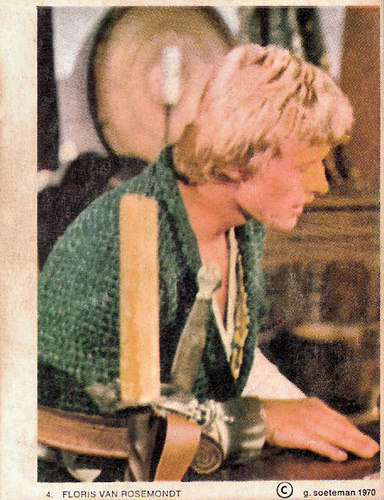
Dutch collectors card, no. 4, 1970. Photo: Gerard Soeteman. Publicity still for the TV series Floris (Paul Verhoeven, 1969). Rutger Hauer as Floris van Rosemondt.
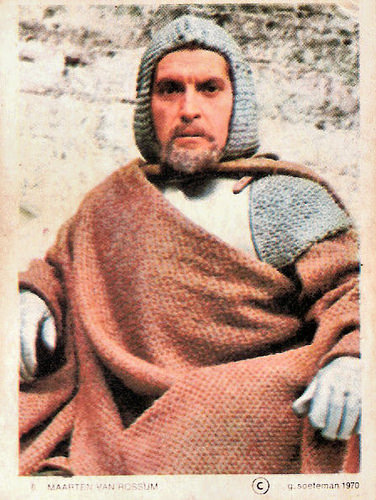
Dutch collectors card, no. 5 (?), 1970. Photo: Gerard Soeteman. Publicity still for the TV series Floris (Paul Verhoeven, 1969). Hans Culeman as Maarten van Rossum.

Dutch collectors card, no. 7, 1970. Photo: Gerard Soeteman. Publicity still for the TV series Floris (Paul Verhoeven, 1969). Hans Boskamp as Lange Pier.
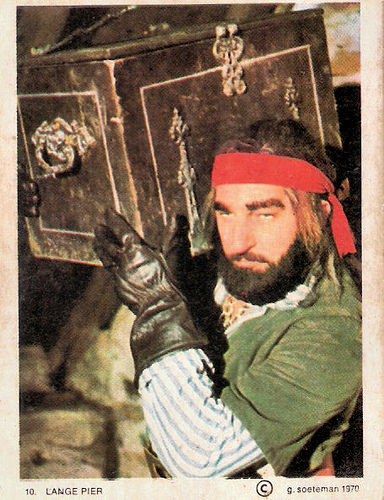
Dutch collectors card, no. 10, 1970. Photo: Gerard Soeteman. Publicity still for the TV series Floris (Paul Verhoeven, 1969). Hans Boskamp as Lange Pier.

Dutch collectors card, no. 14, 1970. Photo: Gerard Soeteman. Publicity still for the TV series Floris (Paul Verhoeven, 1969).
Unforgettable screen debut
I was able to lay my hands on some vintage collectors cards of Floris (1969). These small cards, produced in 1970, are quite rare these days, and therefore my card series is not complete yet.
The Dutch television series, set in the Middle Ages, is the favourite series for many of my generation in the Netherlands and also in Belgium. At the time, all kinds of merchandise was produced for the kids and of course they are a cult now.
In the series, blonde, athletic and the then incredibly young Rutger Hauer made his screen debut as the exiled knight Floris van Rosemondt. His performance is unforgettable, Hauer is the ultimate knight.
With his Indian friend Sindala (Jos Bergman), Floris tries to get his birth right papers back from Maarten van Rossem (Hans Culeman), an evil lord.
During their quest they get help from Wolter van Oldenstein (Ton Vos), a noble man who offers them a place in his castle. They also meet the imposing pirate Lange Pier (Hans Boskamp).
Apart from Sindala and Floris, all the characters are based on historical figures. Scriptwriter Gerard Soeteman did an amazingly inventive job and it is one of the reasons why many adults love to see this children's series too.
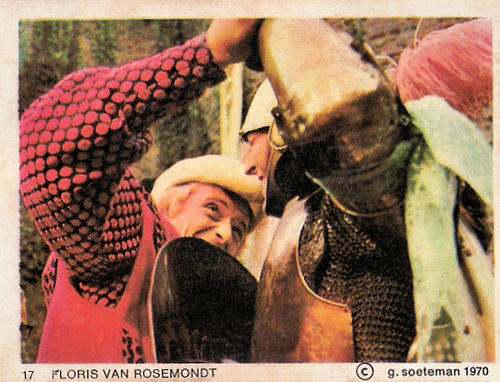
Dutch collectors card, no. 17, 1970. Photo: Gerard Soeteman. Publicity still for the TV series Floris (Paul Verhoeven, 1969).
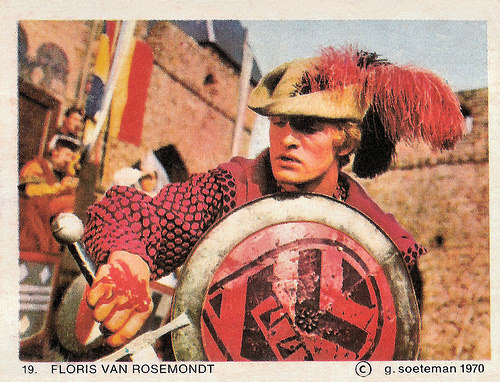
Dutch collectors card, no. 19, 1970. Photo: Gerard Soeteman. Publicity still for the TV series Floris (Paul Verhoeven, 1969).
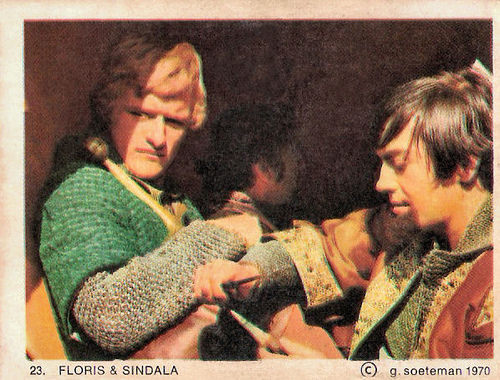
Dutch collectors card, no. 23, 1970. Photo: Gerard Soeteman. Publicity still for the TV series Floris (Paul Verhoeven, 1969).
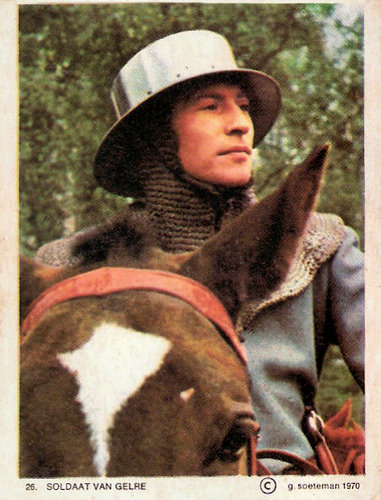
Dutch collectors card, no. 26, 1970. Photo: Gerard Soeteman. Publicity still for the TV series Floris (Paul Verhoeven, 1969). Caption: Soldaat van Gelre (Soldier Van Gelre).
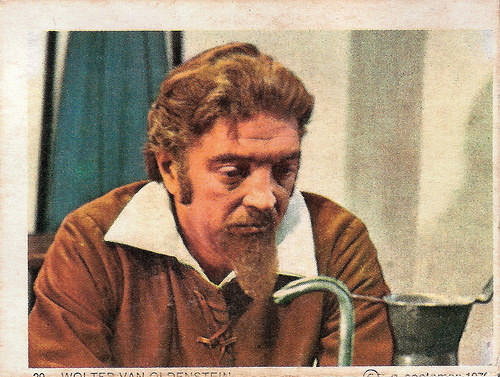
Dutch collectors card, no. 29 (?), 1970. Photo: Gerard Soeteman. Publicity still for the TV series Floris (Paul Verhoeven, 1969). Ton Vos als Wolter van Oldenstein.
In the best Robin Hood style
In 1967, the success of television series like the British Ivanhoe (1958-1959) with Roger Moore , the French Thierry La Fronde/Thierry the Sling (1963-1966) with Jean-Claude Drouot , and the Flemish Johan en de Alverman (1965) with Frank Aendenboom inspired Carel Enkelaar, manager of NTS Television to make a similar series, set in the Netherlands.
Hanne Aboe Derwort highly recommends the series at IMDb : "One of the first Middle Age series ever, the stories of the adventures of Floris in medieval Holland are also among the most funny TV-series ever.
The budget was very low, which can be seen, but the interaction between the actors is nothing less but wonderful. Floris and his trusty companion Sindala is in best Robin Hood style, but with the addition of Eastern magic to the sword fighting skills and sheer strength (and luck) of our hero. (...)
The fact that the series is in b/w actually helps, no need to mess around with anything when somebody's wounded. If you can locate the tapes, watch it."

Dutch collectors card, no. 30, 1970. Photo: Gerard Soeteman. Publicity still for the TV series Floris (Paul Verhoeven, 1969).
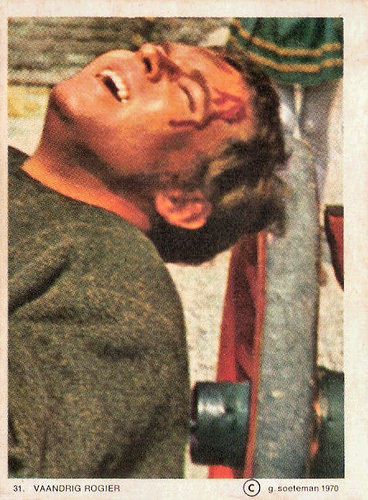
Dutch collectors card, no. 31, 1970. Photo: Gerard Soeteman. Publicity still for the TV series Floris (Paul Verhoeven, 1969). Caption: Vaandrig Rogier (Ensign-bearer Rogier). Rogier was played by Jacco van Renesse.
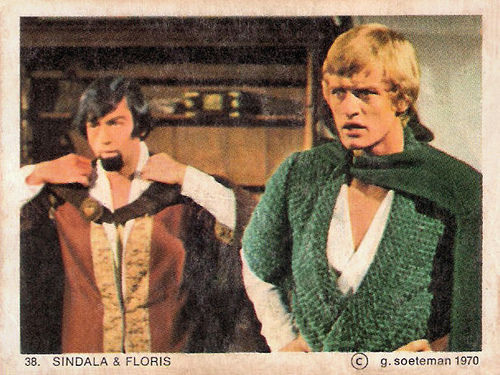
Dutch collectors card, no. 38, 1970. Photo: Gerard Soeteman. Publicity still for the TV series Floris (Paul Verhoeven, 1969).
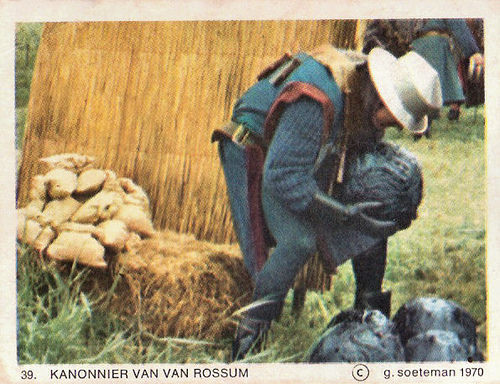
Dutch collectors card, no. 39, 1970. Photo: Gerard Soeteman. Publicity still for the TV series Floris (Paul Verhoeven, 1969). Caption: Kanonnier van Van Rossum (Gunner of Van Rossum).
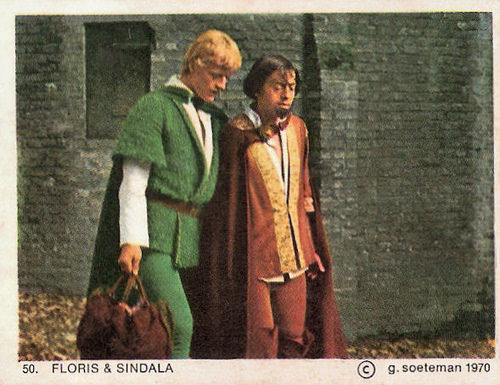
Dutch collectors card, no. 50, 1970. Photo: Gerard Soeteman. Publicity still for the TV series Floris (Paul Verhoeven, 1969).
The most popular TV series in the Netherlands
In 1969, Floris was the most popular TV series in the Netherlands. The series had many reruns through the years. Floris has also been shown in East Germany (as Floris - Der Mann mit dem Schwert) and Scotland dubbed in English. In the UK, the series aired on Yorkshire Television in 1970 as The Adventures of Floris. None of the English dubbed episodes survive.
1975 saw a German remake of the series, Floris von Rosenmund (Ferry Radax, 1975), again starring Rutger Hauer , but with German actor Derval de Faria as Sindala. This version put much more emphasis on the comedic aspects of the stories.
The series also lead to the film Floris (Jean van de Velde, 2004) which features Michiel Huisman (known for his role in Game of Thrones) as the grandson of the original Floris. Some of the footage from the 1969 series with Hauer and Bergman is included. Rutger Hauer was originally asked to play the father of young Floris, but he declined.
In 2016 a small miracle happened. Nearly 47 years after the broadcast of the twelfth and final episode of the legendary TV series Floris, a hitherto unknown thirteenth episode premiered. The episode entitled Het gericht/Targeting was never finished for several reasons. The raw footage was owned by the writer of the series, Gerard Soeteman.
To get a full episode, artist Gerrit Stapel assembled black and white drawings between the images. Previously Stapel made the Floris comics together with Soeteman. In addition to the thirteenth episode, a documentary about the legendary series was produced, in which both Verhoeven and Soeteman provide insight into the development of Floris. Both the 13the episode and the documentary premiered at Doornenburg castle, one of the locations of the Dutch television series. Rutger Hauer, then 72, was present at the belated premiere.
Episode Het brandende water (The burning water). Sorry, no subtitles. Source: eikcid (YouTube). Enjoy the title music! (Julius Steffaro is one of of the many stage names of Jan Stoeckart. At IMDb he is also called Jack Trombley.)
Dutch TV documentary in the series Andere tijden (Other times). Sorry, no subtitles. Source: 192TVideo (YouTube).
Source: Hanne Aboe Derwort (IMDb), Wikipedia and IMDb.

Dutch collectors card, no. 4, 1970. Photo: Gerard Soeteman. Publicity still for the TV series Floris (Paul Verhoeven, 1969). Rutger Hauer as Floris van Rosemondt.

Dutch collectors card, no. 5 (?), 1970. Photo: Gerard Soeteman. Publicity still for the TV series Floris (Paul Verhoeven, 1969). Hans Culeman as Maarten van Rossum.

Dutch collectors card, no. 7, 1970. Photo: Gerard Soeteman. Publicity still for the TV series Floris (Paul Verhoeven, 1969). Hans Boskamp as Lange Pier.

Dutch collectors card, no. 10, 1970. Photo: Gerard Soeteman. Publicity still for the TV series Floris (Paul Verhoeven, 1969). Hans Boskamp as Lange Pier.

Dutch collectors card, no. 14, 1970. Photo: Gerard Soeteman. Publicity still for the TV series Floris (Paul Verhoeven, 1969).
Unforgettable screen debut
I was able to lay my hands on some vintage collectors cards of Floris (1969). These small cards, produced in 1970, are quite rare these days, and therefore my card series is not complete yet.
The Dutch television series, set in the Middle Ages, is the favourite series for many of my generation in the Netherlands and also in Belgium. At the time, all kinds of merchandise was produced for the kids and of course they are a cult now.
In the series, blonde, athletic and the then incredibly young Rutger Hauer made his screen debut as the exiled knight Floris van Rosemondt. His performance is unforgettable, Hauer is the ultimate knight.
With his Indian friend Sindala (Jos Bergman), Floris tries to get his birth right papers back from Maarten van Rossem (Hans Culeman), an evil lord.
During their quest they get help from Wolter van Oldenstein (Ton Vos), a noble man who offers them a place in his castle. They also meet the imposing pirate Lange Pier (Hans Boskamp).
Apart from Sindala and Floris, all the characters are based on historical figures. Scriptwriter Gerard Soeteman did an amazingly inventive job and it is one of the reasons why many adults love to see this children's series too.

Dutch collectors card, no. 17, 1970. Photo: Gerard Soeteman. Publicity still for the TV series Floris (Paul Verhoeven, 1969).

Dutch collectors card, no. 19, 1970. Photo: Gerard Soeteman. Publicity still for the TV series Floris (Paul Verhoeven, 1969).

Dutch collectors card, no. 23, 1970. Photo: Gerard Soeteman. Publicity still for the TV series Floris (Paul Verhoeven, 1969).

Dutch collectors card, no. 26, 1970. Photo: Gerard Soeteman. Publicity still for the TV series Floris (Paul Verhoeven, 1969). Caption: Soldaat van Gelre (Soldier Van Gelre).

Dutch collectors card, no. 29 (?), 1970. Photo: Gerard Soeteman. Publicity still for the TV series Floris (Paul Verhoeven, 1969). Ton Vos als Wolter van Oldenstein.
In the best Robin Hood style
In 1967, the success of television series like the British Ivanhoe (1958-1959) with Roger Moore , the French Thierry La Fronde/Thierry the Sling (1963-1966) with Jean-Claude Drouot , and the Flemish Johan en de Alverman (1965) with Frank Aendenboom inspired Carel Enkelaar, manager of NTS Television to make a similar series, set in the Netherlands.
Hanne Aboe Derwort highly recommends the series at IMDb : "One of the first Middle Age series ever, the stories of the adventures of Floris in medieval Holland are also among the most funny TV-series ever.
The budget was very low, which can be seen, but the interaction between the actors is nothing less but wonderful. Floris and his trusty companion Sindala is in best Robin Hood style, but with the addition of Eastern magic to the sword fighting skills and sheer strength (and luck) of our hero. (...)
The fact that the series is in b/w actually helps, no need to mess around with anything when somebody's wounded. If you can locate the tapes, watch it."

Dutch collectors card, no. 30, 1970. Photo: Gerard Soeteman. Publicity still for the TV series Floris (Paul Verhoeven, 1969).

Dutch collectors card, no. 31, 1970. Photo: Gerard Soeteman. Publicity still for the TV series Floris (Paul Verhoeven, 1969). Caption: Vaandrig Rogier (Ensign-bearer Rogier). Rogier was played by Jacco van Renesse.

Dutch collectors card, no. 38, 1970. Photo: Gerard Soeteman. Publicity still for the TV series Floris (Paul Verhoeven, 1969).

Dutch collectors card, no. 39, 1970. Photo: Gerard Soeteman. Publicity still for the TV series Floris (Paul Verhoeven, 1969). Caption: Kanonnier van Van Rossum (Gunner of Van Rossum).

Dutch collectors card, no. 50, 1970. Photo: Gerard Soeteman. Publicity still for the TV series Floris (Paul Verhoeven, 1969).
The most popular TV series in the Netherlands
In 1969, Floris was the most popular TV series in the Netherlands. The series had many reruns through the years. Floris has also been shown in East Germany (as Floris - Der Mann mit dem Schwert) and Scotland dubbed in English. In the UK, the series aired on Yorkshire Television in 1970 as The Adventures of Floris. None of the English dubbed episodes survive.
1975 saw a German remake of the series, Floris von Rosenmund (Ferry Radax, 1975), again starring Rutger Hauer , but with German actor Derval de Faria as Sindala. This version put much more emphasis on the comedic aspects of the stories.
The series also lead to the film Floris (Jean van de Velde, 2004) which features Michiel Huisman (known for his role in Game of Thrones) as the grandson of the original Floris. Some of the footage from the 1969 series with Hauer and Bergman is included. Rutger Hauer was originally asked to play the father of young Floris, but he declined.
In 2016 a small miracle happened. Nearly 47 years after the broadcast of the twelfth and final episode of the legendary TV series Floris, a hitherto unknown thirteenth episode premiered. The episode entitled Het gericht/Targeting was never finished for several reasons. The raw footage was owned by the writer of the series, Gerard Soeteman.
To get a full episode, artist Gerrit Stapel assembled black and white drawings between the images. Previously Stapel made the Floris comics together with Soeteman. In addition to the thirteenth episode, a documentary about the legendary series was produced, in which both Verhoeven and Soeteman provide insight into the development of Floris. Both the 13the episode and the documentary premiered at Doornenburg castle, one of the locations of the Dutch television series. Rutger Hauer, then 72, was present at the belated premiere.
Episode Het brandende water (The burning water). Sorry, no subtitles. Source: eikcid (YouTube). Enjoy the title music! (Julius Steffaro is one of of the many stage names of Jan Stoeckart. At IMDb he is also called Jack Trombley.)
Dutch TV documentary in the series Andere tijden (Other times). Sorry, no subtitles. Source: 192TVideo (YouTube).
Source: Hanne Aboe Derwort (IMDb), Wikipedia and IMDb.
Published on February 08, 2017 22:00
February 7, 2017
Carte blanche for Didier Hanson
Didier Hanson has a collection of over 6,000 vintage - and often rare - postcards of film actors and other celebrities. We asked him for a new guest post and gave him carte blanche. Didier did not select from his amazing postcards of artists from the Russian Empire, but chose 12 European and American film stars who deserve to be rediscovered, with a focus on France before and during the war.
1. Albert Morys

French poster, dating 16/05/1940, six days after the fall of France! Poster for Après Mein Kampf mes crimes/My Crimes After Mein Kampf (Alexandre Ryder as Jean-Jacques Valjean, 1940). Collection: Didier Hanson.
Didier Hanson: "This poster dates 16/05/1940, six days after the fall of France! What can one say? A lot, it is one of the first anti-Nazi films produced, maybe the first ever produced in an occupied country, absolutely incredible. And in the role of young Hitler.... Albert Morys! He was very lucky to finish the war alive. His career includes other films, theatre and writing..."

French postcard, 1944. Collection: Didier Hanson.
2. Olive Thomas

American postcard by Photocard Co., L.A., no. 105.
"Thomas (1894-1920) was the sweetheart and wife of Jack Pickford. On vacation, at the Hotel Ritz in Paris, she swallowed (by error, suicide?) a very toxic medication prescribed to her husband for his chronic syphilis. This was the first and official version. The second was sleazier. Thomas, a heavy drug addict, went out at night in the seedy Parisian bas quartiers to buy her ration of white powder. Was it cut with strychnine, or did she ingest too much of it? A mystery. This scandal was the first big scandal in Hollywood before Fatty Arbuckle. Ah! What a hard life these movie stars had!"
3. Lya de Putti

Vintage postcard. Collection: Didier Hanson.
"If you read some of my occasional texts, you know my love (yes, the word is correct. I love her, a post-mortem platonic love. By the way, I am happily married...) as I love Anita Berber , La Jana and some others.) So... Why this picture? Because she has a hairdo which was not her trademark, and which makes her a more feminine vamp than the usual one. Rest peacefully Lya, your life has been complicated enough."
4. Corinne Luchaire

French postcard, no. 63. Photo: Studio Piaz. Collection: Didier Hanson.
"Young star, daughter of a press magnate, but unfortunately a collaborationist. She was in fact raised by Nazis and collaborationists. She became ill (tuberculosis) but still, she kept living a life of banquets at Maxim's, parties, etc. Her film career is very thin. To make it short, she was arrested in May 1945 and condemned to 10 years of 'national indignity'. Her father was executed in 1946. She herself died from tuberculosis in 1956. La vie n'est pas toujours du cinéma....."
5. Mireille Balin

French postcard by Viny, no. 4. Photo: R.A.C.
"Another collateral war damage. Superb actress... remember Pepe le Moko? She was also discredited by her fraternisation with Nazis, but not only... Nothing precise can be said about her. She died penniless, from alcoholism, but fortunately a wealthy ex-lover, T.R. , paid for the funeral expenses, as he did also for Jean Tissier . So, T.R. redeemed himself, his life had not been a immaculate model. But this is another story."
6. Jean Tissier

French postcard, no. 16. Photo Studio Paz. Collection: Didier Hanson.
"Today, this actor is relatively unknown, but he played in more than 200 movies, nobody knows the exact number, and numerous theatre plays. In the thirties/forties he was one of the top French stars, just below Fernandel , Michel Simon , Gabin .... But the success faded away with the years. Tissier loved a luxurious life, and became almost indigent. BUT, after being engaged by Jean Pierre Mocky, his name resurfaced for a while, and he ended his life with honours for his part in La veuve Couderc (1971). During his career, he starred in numerous turkeys, but he brought something to each of them. And he was a really great actor. In my opinion he has a place among the 10 most valuable French actors (you won't get the names for the 9 others, I am a well educated person)."
7. Robert Le Vigan

French postcard by Edit. Chantal, Rueil, no. 576. Photo: U.F.P.C. Collection: Didier Hanson.
"Great actor, theatre and cinema.... Unfortunately, ideologies - fallacious or not - can induce vertigo, and a downloading spiral... Remember La Bandera? Le Quai des brûmes? Well, my comment stops here. He died in 1972, he had fled to South America to escape a certain death penalty... Immanent justice was served. Period."
8. Tamara Desni

German postcard. Photo: Becker & Maass, Berlin. Collection: Didier Hanson.
"Here she was a beautiful young dancer in Berlin, only 14. The postcard has no number, because it was a proof that Tamara's daughter gave me. Desni was not an immense actress, more a dancer. Her real name was Tamara Brodski. Her father abandoned her and her sister to try his luck in the US, and nobody knew what ever became of him. I found, by chance the pressing with its reference number some years ago... In 2008, Tamara Desni died, at a grand age."
9. Theda Bara

British postcard in the Lilywhite Photographic series. Photo: William Fox. Collection: Didier Hanson.
"Her real name was Theodosia Goodman. She was the daughter of a Jewish tailor and his wife. THE archetypal Vamp, and one of the greatest stars of the silent era. Theda Bara is an anagram, no need to reveal what it means. Maybe without her, there would have been no Vampira, no Elvira.... Who knows? I selected this postcard because her attire was not what we are used to see worn by our vamps."
10. Max Dearly and Mistinguett

French postcard by F.C. & Cie, no. 283. Photo: Boyer & Bert. Collection: Didier Hanson.
"A more than superb dancing duo. Their Apache dance was a triumph, to say the least. The whole world knew Mistinguett as a show girl, singer and revue leader... Less known was Max Dearly . He was not English as his name suggests, but a French actor, spiritual, gifted. After having begun his career as a dancer and acrobat, he had a film and theatre career. (Superb photo by Boyer et Bert)."
11. Yvette Guilbert

German postcard by Ross Verlag, no. 62/2. Photo: Parufamet / Ufa. Still with Emil Jannings as Mephisto and Yvette Guilbert as Marthe in Faust (F.W. Murnau, 1926). Collection: Didier Hanson.
"Nothing really special, if not for the duo Emil Jannings and Yvette Guilbert. Guilbert was a curiosity, famous for the song Le Fiacre. She was immortalised by Toulouse-Lautrec... and Faust was a film by F.W. Murnau. Guilbert had a nice, rather short but prestigious cinematographic career!"
12. Barbara La Marr

French postcard, no. 812. Photo: Eneret. Collection: Didier Hanson.
"A special picture with bicorne before the ravages of 'the powder of joy' on her beautiful face....."
Thank you, Didier!
Read here an earlier guest post by Didier Hanson. At Flickr we've made an album with rare vintage postcards from the amazing collection of Didier.
1. Albert Morys

French poster, dating 16/05/1940, six days after the fall of France! Poster for Après Mein Kampf mes crimes/My Crimes After Mein Kampf (Alexandre Ryder as Jean-Jacques Valjean, 1940). Collection: Didier Hanson.
Didier Hanson: "This poster dates 16/05/1940, six days after the fall of France! What can one say? A lot, it is one of the first anti-Nazi films produced, maybe the first ever produced in an occupied country, absolutely incredible. And in the role of young Hitler.... Albert Morys! He was very lucky to finish the war alive. His career includes other films, theatre and writing..."

French postcard, 1944. Collection: Didier Hanson.
2. Olive Thomas

American postcard by Photocard Co., L.A., no. 105.
"Thomas (1894-1920) was the sweetheart and wife of Jack Pickford. On vacation, at the Hotel Ritz in Paris, she swallowed (by error, suicide?) a very toxic medication prescribed to her husband for his chronic syphilis. This was the first and official version. The second was sleazier. Thomas, a heavy drug addict, went out at night in the seedy Parisian bas quartiers to buy her ration of white powder. Was it cut with strychnine, or did she ingest too much of it? A mystery. This scandal was the first big scandal in Hollywood before Fatty Arbuckle. Ah! What a hard life these movie stars had!"
3. Lya de Putti

Vintage postcard. Collection: Didier Hanson.
"If you read some of my occasional texts, you know my love (yes, the word is correct. I love her, a post-mortem platonic love. By the way, I am happily married...) as I love Anita Berber , La Jana and some others.) So... Why this picture? Because she has a hairdo which was not her trademark, and which makes her a more feminine vamp than the usual one. Rest peacefully Lya, your life has been complicated enough."
4. Corinne Luchaire

French postcard, no. 63. Photo: Studio Piaz. Collection: Didier Hanson.
"Young star, daughter of a press magnate, but unfortunately a collaborationist. She was in fact raised by Nazis and collaborationists. She became ill (tuberculosis) but still, she kept living a life of banquets at Maxim's, parties, etc. Her film career is very thin. To make it short, she was arrested in May 1945 and condemned to 10 years of 'national indignity'. Her father was executed in 1946. She herself died from tuberculosis in 1956. La vie n'est pas toujours du cinéma....."
5. Mireille Balin

French postcard by Viny, no. 4. Photo: R.A.C.
"Another collateral war damage. Superb actress... remember Pepe le Moko? She was also discredited by her fraternisation with Nazis, but not only... Nothing precise can be said about her. She died penniless, from alcoholism, but fortunately a wealthy ex-lover, T.R. , paid for the funeral expenses, as he did also for Jean Tissier . So, T.R. redeemed himself, his life had not been a immaculate model. But this is another story."
6. Jean Tissier

French postcard, no. 16. Photo Studio Paz. Collection: Didier Hanson.
"Today, this actor is relatively unknown, but he played in more than 200 movies, nobody knows the exact number, and numerous theatre plays. In the thirties/forties he was one of the top French stars, just below Fernandel , Michel Simon , Gabin .... But the success faded away with the years. Tissier loved a luxurious life, and became almost indigent. BUT, after being engaged by Jean Pierre Mocky, his name resurfaced for a while, and he ended his life with honours for his part in La veuve Couderc (1971). During his career, he starred in numerous turkeys, but he brought something to each of them. And he was a really great actor. In my opinion he has a place among the 10 most valuable French actors (you won't get the names for the 9 others, I am a well educated person)."
7. Robert Le Vigan

French postcard by Edit. Chantal, Rueil, no. 576. Photo: U.F.P.C. Collection: Didier Hanson.
"Great actor, theatre and cinema.... Unfortunately, ideologies - fallacious or not - can induce vertigo, and a downloading spiral... Remember La Bandera? Le Quai des brûmes? Well, my comment stops here. He died in 1972, he had fled to South America to escape a certain death penalty... Immanent justice was served. Period."
8. Tamara Desni

German postcard. Photo: Becker & Maass, Berlin. Collection: Didier Hanson.
"Here she was a beautiful young dancer in Berlin, only 14. The postcard has no number, because it was a proof that Tamara's daughter gave me. Desni was not an immense actress, more a dancer. Her real name was Tamara Brodski. Her father abandoned her and her sister to try his luck in the US, and nobody knew what ever became of him. I found, by chance the pressing with its reference number some years ago... In 2008, Tamara Desni died, at a grand age."
9. Theda Bara

British postcard in the Lilywhite Photographic series. Photo: William Fox. Collection: Didier Hanson.
"Her real name was Theodosia Goodman. She was the daughter of a Jewish tailor and his wife. THE archetypal Vamp, and one of the greatest stars of the silent era. Theda Bara is an anagram, no need to reveal what it means. Maybe without her, there would have been no Vampira, no Elvira.... Who knows? I selected this postcard because her attire was not what we are used to see worn by our vamps."
10. Max Dearly and Mistinguett

French postcard by F.C. & Cie, no. 283. Photo: Boyer & Bert. Collection: Didier Hanson.
"A more than superb dancing duo. Their Apache dance was a triumph, to say the least. The whole world knew Mistinguett as a show girl, singer and revue leader... Less known was Max Dearly . He was not English as his name suggests, but a French actor, spiritual, gifted. After having begun his career as a dancer and acrobat, he had a film and theatre career. (Superb photo by Boyer et Bert)."
11. Yvette Guilbert

German postcard by Ross Verlag, no. 62/2. Photo: Parufamet / Ufa. Still with Emil Jannings as Mephisto and Yvette Guilbert as Marthe in Faust (F.W. Murnau, 1926). Collection: Didier Hanson.
"Nothing really special, if not for the duo Emil Jannings and Yvette Guilbert. Guilbert was a curiosity, famous for the song Le Fiacre. She was immortalised by Toulouse-Lautrec... and Faust was a film by F.W. Murnau. Guilbert had a nice, rather short but prestigious cinematographic career!"
12. Barbara La Marr

French postcard, no. 812. Photo: Eneret. Collection: Didier Hanson.
"A special picture with bicorne before the ravages of 'the powder of joy' on her beautiful face....."
Thank you, Didier!
Read here an earlier guest post by Didier Hanson. At Flickr we've made an album with rare vintage postcards from the amazing collection of Didier.
Published on February 07, 2017 22:00
February 6, 2017
102-year-old Hungarian film discovered in Amsterdam
Dutch researchers at the Amsterdam-based EYE Film Institute have discovered one of the oldest extant Hungarian films: A Munkászubbony/The Work Jacket, first shown on 12 January 1915. Lost for decades, The Work Jacket is one of the longest Hungarian silent films of the era. The film, directed by István Bródy, stars Gyula Hegedűs, one of the most important actors of his day in Hungary. We don't have any postcards of the film nor of Hegedűs in our celebration, but EFSP celebrates this wonderful news with postcards of 12 stars of the silent Hungarian cinema.

Austrian postcard by Iris Verlag, no. 323. Photo: Fayer.
Hungarian actress and singer Sári Fedák (1879-1955) was one of the most famous prima donnas of her time. The temperamental operetta and film star was mixed up in several scandals. In 1912, she made her film debut in the short comedy Gazdag ember kabátja/Rich man’s coat (Andor K. Kovács, 1912) based on a story by the famous Hungarian playwright and novelist Ferenc Molnár. The next year, she co-starred with Alfréd Deésy in Rablélek (1913), directed by Mihály Kertész who later became the famous Hollywood director Michael Curtiz.

Hungarian postcard. Photo: Strelisky, Budapest, 1913. Lily Berky in the operetta Aranyesö, composed by Béla Zerkovitz and with a libretto by Adolf Mérei and Izor Béldia.
Lili Berky (1886–1958) was a Hungarian stage and screen actress, who starred in over 30 Hungarian silent films between 1913 and the late 1920s and played in an equal amount of Hungarian sound films, mainly in the 1930s and early 1940s. Berky's first big success was the silent drama Sárga csikó/The Yellow Foal (Félix Vanyl, 1913), co-starring Gyula Nagy and Victor Varconi. In 1917 she became the wife of Hungarian actor and comedian Gyula Gózon. They often performed together.

German postcard by NPG. Photo: Mátrai, Budapest.
Hungarian stage and film actor Oscar Beregi, Sr. (1876-1965) appeared in 27 European and American films between 1916 and 1953. He is best remembered as Dr. Baum in Fritz Lang’s Das Testament des Dr. Mabuse (1933). The sources differ about Beregi’s film debut in 1916. Was it with the lead role in the silent Hungarian production Mire megvénülünk/The time we get old (Ödön Uher ifj., 1916) or with the male lead in Hófehérke/Snowwhite (Márton Garas, 1916) with Ica von Lenkeffy? A year later he starred in the drama A Gólyakalifa/The Stork Caliph (Korda Sándor a.k.a. Alexander Korda, 1917), co-starring Gyula Bartos and Judit Bánky. It was the second film made by the legendary director-producer for his newly established Corvin Film company.

Vintage postcard by Verlag Hartiq, no. 576. Photo: Hartiq. Collection: Didier Hanson.
Fat Hungarian stage and film comedian Karl Huszár-Puffy (1884–1942 or 1943) was the most popular slapstick star of the Hungarian silent era. He started his film career as Károly Huszár in such silent shorts as Víg egyveleg, avagy Pufi és társai (Kornél Tábori, 1914) and Pufi cipöt vesz/Puffy buys shoes (Kornél Tábori, 1914). In these films he played a character called Pufi. It became his nickname and stage name. In 1917 he worked with director Michael Curtiz (then still Mihály Kertész) at Tavasz a télben/Spring in Winter (1917), and Az Ezredes/The Colonel (1917) with the young Béla Lugosi. That year he also worked with another famous director-to-be, Alexander Korda (as Korda Sándor), at Szent Péter esernyöje/St. Peter's Umbrella (1917) with Victor Varconi.

Hungarian postcard by Veres, no. 77.
Emmi Kosáry (1889-1964) was a Hungarian opera diva and operetta prima donna with a beautiful soprano voice. She also became a film actress, who worked in Hungary with the young Michael Curtiz. Kosáry was the wife of composer Ákos Buttykay. In 1917, Kosáry made her film debut in the silent film Tatárjárás/Tartar Invasion (1917) with Camilla von Hollay. The film was directed by Mihály Kertész who later became famous as Hollywood director Michael Curtiz.

Hungarian postcard by B.J., Budapest.
Handsome Victor Varconi (1891–1976) was a highly successful matinee idol of the Hungarian-Austrian and German silent cinema in the 1910s and early 1920s. The young good-looking actor thrived for a time on the Transylvanian stage, where he played leads in such productions as Liliom at the Hungarian National Theatre in Budapest. His rising popularity as a matinee idol led to film roles, and he made his debut in Sárga csikó/Son of the Pusta (Félix Vanyl, 1913). Other of his silent Hungarian films were Bánk Bán (Mihály Kertész aka Michael Curtiz, 1914) based on the play by József Katona, Mágia/Magic (Sándor Korda aka Alexander Korda, 1917), Szent Péter esernyöje/St. Peter's Umbrella (Alexander Korda, 1917) and Fehér rózsa/White Rose (Alexander Korda, 1919) starring Maria Corda, the director’s wife. Unfortunately nearly all these early films got lost. Later Varconi was the first Hungarian actor to become a Hollywood star until the sound film completely altered the course of his career.
The Hungarian silent cinema
Hungary has had a notable cinema industry from the beginning of the 20th century, and Hungarians affected the film world both inside and outside the borders. William Fox (born Wilhelm Fuchs) founded Fox Studios, Alexander Korda (Sándor László Kellner) played a leading role in the Britain's film industry, and Adolph Zukor founded Paramount Pictures.
The story of the Hungarian Cinema begins in 1896, when the first screening of the films of the Lumiére brothers was held at 10 May in the cafe of the Royal Hotel of Budapest. In June of the same year, Arnold and Zsigmond Sziklai opened the first Hungarian cinema at the 41. Andrássy street, named the Okonograph.
The first Hungarian fiction film was A tánc/The Dance directed by Béla Zsitkovszky, made as an illustration to one of the shows of the Uránia Scientific Theatre, where Béla Zsitovszky, was the projectionist. Zsitovszky, originally an optician, shot the picture on the roof terrace of the theatre with renowned actors and ballerinas of the Operaház theatre. A tánc premiered on 30 April 1901.
According to Wikipedia , a characteristic style of early Hungarian cinema was the cinema sketch, a hybrid form of theatre and film. Each short projection was followed or interrupted by live stage actors, often acting their own characters from the screen. The genre inspired many prominent writers of the time, including Ferenc Molnár and Frigyes Karinthy. Comedians also used this form often to perform various jokes and scenes utilising its hybrid nature, one well-known performer being Gyula Gózon.
Mór Undergleider also started a professional journal on the subject of cinema, called Mozgófénykép Híradó (News of Moving Picture). The journal published articles of numerous renowned writers, theatrical directors, aestheticans and scientists about motion picture, including the pioneering film-theory articles of the 18-year-old Alexander Korda.
During 1919 March–August, under the short-lived Hungarian Soviet Republic, the Hungarian cinema industry was the first one to be nationalised fully. The journal Vörös film (Red film) was started to popularise the shift. A number of filmmakers welcomed the change, as the government provided protection against competing foreign films.
The Hungarian Soviet Republic was short-lived and the period of political instability left the sprouting Hungarian film industry in ruins. Directors Michael Curtiz, who shot a total of 38 films in Hungary, and Alexander Korda had left the country and made their careers abroad.
During the 1920s, foreign companies made use of the economical crisis in Hungary by gaining hold of nearly all of the country's theatres. American, French and Italian films were all over the screens, leaving little ground for immature Hungarian productions, and the few companies drifted towards bankruptcy.

German postcard by Ross Verlag, no. 1454/3, 1927-1928. Photo: Angelo Photos.
Hungarian actor Iván Petrovich (1894-1962) started his career as Svetislav Petrovic with silent Hungarian films and appeared till his death in nearly 100 European films. The handsome and elegant Petrovich worked on stage as a singer and started to appear in silent films. To his early work belong Hungarian films as A Napraforgós hölgy/The Sunflower Woman (Mihály Kertész, aka Michael Curtiz, 1918) starring Lucy Doraine, and Lengyelvér/Polish Blood (Béla Balogh, 1920).
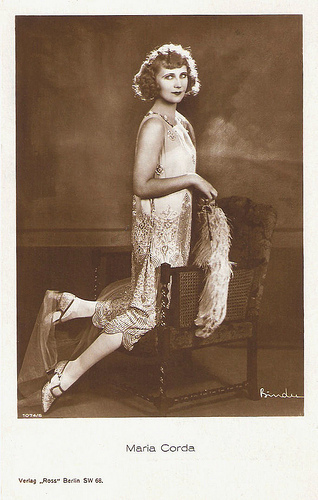
German postcard by Ross Verlag, no. 1074/6, 1927-1928. Photo: Alex Binder.
Hungarian Maria Corda (1898-1975) was an immensely popular star of the silent cinema of Austria and Germany. The pretty, blonde actress was a queen of the popular epic spectacles of the 1920s, which were often directed by her husband, Alexander Korda. She began her acting career in the theatres of Budapest in the early days of World War I. Soon after Hungary became an independent state she began to work in the film industry as well. As Antónia Farkas she made her first film appearance in Se ki, se be/Not In, or Out (Sándor Korda aka Alexander Korda, 1919). In 1919 she married her director, but she would always write her last name differently to differentiate herself from her husband. He featured her in Fehér rózsa/The White Rose (Alexander Korda, 1919), Ave Caesar! (Alexander Korda, 1919) and A 111-es/Number 111 (Alexander Korda, 1919). Then, she followed Korda when he journeyed to Vienna to join the Sascha Film Company.

Hungarian postcard. Photo: Angelo, Budapest. Collection: Didier Hanson.
Hungarian actor Béla Lugosi (1882–1956) is best known as the vampire Count Dracula in the horror classic Dracula (1931). He started his film career in the silent Hungarian cinema and later also appeared in German silent films. In 1917 he made his film debut in Az ezredes/The Colonel (Mihály Kertész a.k.a. Michael Curtiz, 1917). In the next two years, Lugosi made 12 films in Hungary, credited as Arisztid Olt, including Nászdal/The Wedding March (Alfréd Deésy, 1917) and Lulu (Michael Curtiz, 1918). After the collapse of Béla Kun's Hungarian Soviet Republic in 1919, leftists and trade unionists became vulnerable. Due to his participation in the formation of an actors’ union, Lugosi was proscribed from acting and so had to leave his homeland.

Hungarian postcard by FMSI, no.17. Photo: Korvin / Joe May Film.
Hollywood actor Paul Lukas (1891-1971) was born as born Pál Lukács in Budapest. In 1917, he made his film debut in Sphynx/Sphinx (Béla Balogh, 1918). Among his other Hungarian films are Udvari levegö/Song of the Heart (Béla Balogh, 1918) and Masamód/The Milliner (László Márkus, 1920) with Ica von Lenkeffy. He had a successful stage and film career in Hungary, Germany and Austria where he worked with Max Reinhardt. In 1927, he arrived in Hollywood.

Hungarian postcard. Publisher: Globus, Budapest. Photo: Angelo Photos. Collection: Didier Hanson.
Popular Hungarian cabaret artist and theatrical actress Franciska Gaál (1904-1973) starred in several European films of the 1920s and 1930s. Her film debut in Hungary was the short silent film Az Egér/The Mouse (Lajos Gellért, 1921). Two other silent films followed, A cornevillei harangok/The bells of Corneville (Antal Forgács, 1921) and New-York express kábel/New York Express cable (Márton Garas, 1921). But after these films, she focused on the stage. Several plays were written especially for her, including A jó tündér (The Good Fairy, 1930) and Valaki (Violet, 1931) by Ferenc Molnár. She was thus a highly successful stage actress, when producer Joe Pasternak engaged her for Universal's European subsidiary Deutsche Universal. Later she went to Hollywood to star in Cecil B. DeMille's The Buccaneer (1938) and other films.

Austrian postcard by Iris Verlag, no. 592. Photo: Allianz Film.
Hungarian actor and film director Julius von Szöreghy (1883-1943) was one of the busiest supporting actors of the German and Austrian cinema in the second half of the 1920s. His film appearances began in 1913 under his own name Gyula Szöreghy. Among his silent Hungarian films are Mary Ann (Alexander Korda, 1918) starring Ica von Lenkeffy, and the drama Fehér rózsa/White Rose (Alexander Korda, 1919) starring María Corda. Fehér rózsa/White Rose was released by the state-owned Hungarian film industry during the Hungarian Soviet Republic, although production had begun before the regime came to power. He also played Sikes in Twist Olivér/Oliver Twist (Márton Garas, 1919), a Hungarian adaptation of the novel by Charles Dickens. In 1920, he moved to Vienna in Austria, and changed his name to Julius von Szöreghy.
Sources: Hungary Today, Wikipedia and .

Austrian postcard by Iris Verlag, no. 323. Photo: Fayer.
Hungarian actress and singer Sári Fedák (1879-1955) was one of the most famous prima donnas of her time. The temperamental operetta and film star was mixed up in several scandals. In 1912, she made her film debut in the short comedy Gazdag ember kabátja/Rich man’s coat (Andor K. Kovács, 1912) based on a story by the famous Hungarian playwright and novelist Ferenc Molnár. The next year, she co-starred with Alfréd Deésy in Rablélek (1913), directed by Mihály Kertész who later became the famous Hollywood director Michael Curtiz.

Hungarian postcard. Photo: Strelisky, Budapest, 1913. Lily Berky in the operetta Aranyesö, composed by Béla Zerkovitz and with a libretto by Adolf Mérei and Izor Béldia.
Lili Berky (1886–1958) was a Hungarian stage and screen actress, who starred in over 30 Hungarian silent films between 1913 and the late 1920s and played in an equal amount of Hungarian sound films, mainly in the 1930s and early 1940s. Berky's first big success was the silent drama Sárga csikó/The Yellow Foal (Félix Vanyl, 1913), co-starring Gyula Nagy and Victor Varconi. In 1917 she became the wife of Hungarian actor and comedian Gyula Gózon. They often performed together.

German postcard by NPG. Photo: Mátrai, Budapest.
Hungarian stage and film actor Oscar Beregi, Sr. (1876-1965) appeared in 27 European and American films between 1916 and 1953. He is best remembered as Dr. Baum in Fritz Lang’s Das Testament des Dr. Mabuse (1933). The sources differ about Beregi’s film debut in 1916. Was it with the lead role in the silent Hungarian production Mire megvénülünk/The time we get old (Ödön Uher ifj., 1916) or with the male lead in Hófehérke/Snowwhite (Márton Garas, 1916) with Ica von Lenkeffy? A year later he starred in the drama A Gólyakalifa/The Stork Caliph (Korda Sándor a.k.a. Alexander Korda, 1917), co-starring Gyula Bartos and Judit Bánky. It was the second film made by the legendary director-producer for his newly established Corvin Film company.

Vintage postcard by Verlag Hartiq, no. 576. Photo: Hartiq. Collection: Didier Hanson.
Fat Hungarian stage and film comedian Karl Huszár-Puffy (1884–1942 or 1943) was the most popular slapstick star of the Hungarian silent era. He started his film career as Károly Huszár in such silent shorts as Víg egyveleg, avagy Pufi és társai (Kornél Tábori, 1914) and Pufi cipöt vesz/Puffy buys shoes (Kornél Tábori, 1914). In these films he played a character called Pufi. It became his nickname and stage name. In 1917 he worked with director Michael Curtiz (then still Mihály Kertész) at Tavasz a télben/Spring in Winter (1917), and Az Ezredes/The Colonel (1917) with the young Béla Lugosi. That year he also worked with another famous director-to-be, Alexander Korda (as Korda Sándor), at Szent Péter esernyöje/St. Peter's Umbrella (1917) with Victor Varconi.

Hungarian postcard by Veres, no. 77.
Emmi Kosáry (1889-1964) was a Hungarian opera diva and operetta prima donna with a beautiful soprano voice. She also became a film actress, who worked in Hungary with the young Michael Curtiz. Kosáry was the wife of composer Ákos Buttykay. In 1917, Kosáry made her film debut in the silent film Tatárjárás/Tartar Invasion (1917) with Camilla von Hollay. The film was directed by Mihály Kertész who later became famous as Hollywood director Michael Curtiz.

Hungarian postcard by B.J., Budapest.
Handsome Victor Varconi (1891–1976) was a highly successful matinee idol of the Hungarian-Austrian and German silent cinema in the 1910s and early 1920s. The young good-looking actor thrived for a time on the Transylvanian stage, where he played leads in such productions as Liliom at the Hungarian National Theatre in Budapest. His rising popularity as a matinee idol led to film roles, and he made his debut in Sárga csikó/Son of the Pusta (Félix Vanyl, 1913). Other of his silent Hungarian films were Bánk Bán (Mihály Kertész aka Michael Curtiz, 1914) based on the play by József Katona, Mágia/Magic (Sándor Korda aka Alexander Korda, 1917), Szent Péter esernyöje/St. Peter's Umbrella (Alexander Korda, 1917) and Fehér rózsa/White Rose (Alexander Korda, 1919) starring Maria Corda, the director’s wife. Unfortunately nearly all these early films got lost. Later Varconi was the first Hungarian actor to become a Hollywood star until the sound film completely altered the course of his career.
The Hungarian silent cinema
Hungary has had a notable cinema industry from the beginning of the 20th century, and Hungarians affected the film world both inside and outside the borders. William Fox (born Wilhelm Fuchs) founded Fox Studios, Alexander Korda (Sándor László Kellner) played a leading role in the Britain's film industry, and Adolph Zukor founded Paramount Pictures.
The story of the Hungarian Cinema begins in 1896, when the first screening of the films of the Lumiére brothers was held at 10 May in the cafe of the Royal Hotel of Budapest. In June of the same year, Arnold and Zsigmond Sziklai opened the first Hungarian cinema at the 41. Andrássy street, named the Okonograph.
The first Hungarian fiction film was A tánc/The Dance directed by Béla Zsitkovszky, made as an illustration to one of the shows of the Uránia Scientific Theatre, where Béla Zsitovszky, was the projectionist. Zsitovszky, originally an optician, shot the picture on the roof terrace of the theatre with renowned actors and ballerinas of the Operaház theatre. A tánc premiered on 30 April 1901.
According to Wikipedia , a characteristic style of early Hungarian cinema was the cinema sketch, a hybrid form of theatre and film. Each short projection was followed or interrupted by live stage actors, often acting their own characters from the screen. The genre inspired many prominent writers of the time, including Ferenc Molnár and Frigyes Karinthy. Comedians also used this form often to perform various jokes and scenes utilising its hybrid nature, one well-known performer being Gyula Gózon.
Mór Undergleider also started a professional journal on the subject of cinema, called Mozgófénykép Híradó (News of Moving Picture). The journal published articles of numerous renowned writers, theatrical directors, aestheticans and scientists about motion picture, including the pioneering film-theory articles of the 18-year-old Alexander Korda.
During 1919 March–August, under the short-lived Hungarian Soviet Republic, the Hungarian cinema industry was the first one to be nationalised fully. The journal Vörös film (Red film) was started to popularise the shift. A number of filmmakers welcomed the change, as the government provided protection against competing foreign films.
The Hungarian Soviet Republic was short-lived and the period of political instability left the sprouting Hungarian film industry in ruins. Directors Michael Curtiz, who shot a total of 38 films in Hungary, and Alexander Korda had left the country and made their careers abroad.
During the 1920s, foreign companies made use of the economical crisis in Hungary by gaining hold of nearly all of the country's theatres. American, French and Italian films were all over the screens, leaving little ground for immature Hungarian productions, and the few companies drifted towards bankruptcy.

German postcard by Ross Verlag, no. 1454/3, 1927-1928. Photo: Angelo Photos.
Hungarian actor Iván Petrovich (1894-1962) started his career as Svetislav Petrovic with silent Hungarian films and appeared till his death in nearly 100 European films. The handsome and elegant Petrovich worked on stage as a singer and started to appear in silent films. To his early work belong Hungarian films as A Napraforgós hölgy/The Sunflower Woman (Mihály Kertész, aka Michael Curtiz, 1918) starring Lucy Doraine, and Lengyelvér/Polish Blood (Béla Balogh, 1920).

German postcard by Ross Verlag, no. 1074/6, 1927-1928. Photo: Alex Binder.
Hungarian Maria Corda (1898-1975) was an immensely popular star of the silent cinema of Austria and Germany. The pretty, blonde actress was a queen of the popular epic spectacles of the 1920s, which were often directed by her husband, Alexander Korda. She began her acting career in the theatres of Budapest in the early days of World War I. Soon after Hungary became an independent state she began to work in the film industry as well. As Antónia Farkas she made her first film appearance in Se ki, se be/Not In, or Out (Sándor Korda aka Alexander Korda, 1919). In 1919 she married her director, but she would always write her last name differently to differentiate herself from her husband. He featured her in Fehér rózsa/The White Rose (Alexander Korda, 1919), Ave Caesar! (Alexander Korda, 1919) and A 111-es/Number 111 (Alexander Korda, 1919). Then, she followed Korda when he journeyed to Vienna to join the Sascha Film Company.

Hungarian postcard. Photo: Angelo, Budapest. Collection: Didier Hanson.
Hungarian actor Béla Lugosi (1882–1956) is best known as the vampire Count Dracula in the horror classic Dracula (1931). He started his film career in the silent Hungarian cinema and later also appeared in German silent films. In 1917 he made his film debut in Az ezredes/The Colonel (Mihály Kertész a.k.a. Michael Curtiz, 1917). In the next two years, Lugosi made 12 films in Hungary, credited as Arisztid Olt, including Nászdal/The Wedding March (Alfréd Deésy, 1917) and Lulu (Michael Curtiz, 1918). After the collapse of Béla Kun's Hungarian Soviet Republic in 1919, leftists and trade unionists became vulnerable. Due to his participation in the formation of an actors’ union, Lugosi was proscribed from acting and so had to leave his homeland.

Hungarian postcard by FMSI, no.17. Photo: Korvin / Joe May Film.
Hollywood actor Paul Lukas (1891-1971) was born as born Pál Lukács in Budapest. In 1917, he made his film debut in Sphynx/Sphinx (Béla Balogh, 1918). Among his other Hungarian films are Udvari levegö/Song of the Heart (Béla Balogh, 1918) and Masamód/The Milliner (László Márkus, 1920) with Ica von Lenkeffy. He had a successful stage and film career in Hungary, Germany and Austria where he worked with Max Reinhardt. In 1927, he arrived in Hollywood.

Hungarian postcard. Publisher: Globus, Budapest. Photo: Angelo Photos. Collection: Didier Hanson.
Popular Hungarian cabaret artist and theatrical actress Franciska Gaál (1904-1973) starred in several European films of the 1920s and 1930s. Her film debut in Hungary was the short silent film Az Egér/The Mouse (Lajos Gellért, 1921). Two other silent films followed, A cornevillei harangok/The bells of Corneville (Antal Forgács, 1921) and New-York express kábel/New York Express cable (Márton Garas, 1921). But after these films, she focused on the stage. Several plays were written especially for her, including A jó tündér (The Good Fairy, 1930) and Valaki (Violet, 1931) by Ferenc Molnár. She was thus a highly successful stage actress, when producer Joe Pasternak engaged her for Universal's European subsidiary Deutsche Universal. Later she went to Hollywood to star in Cecil B. DeMille's The Buccaneer (1938) and other films.

Austrian postcard by Iris Verlag, no. 592. Photo: Allianz Film.
Hungarian actor and film director Julius von Szöreghy (1883-1943) was one of the busiest supporting actors of the German and Austrian cinema in the second half of the 1920s. His film appearances began in 1913 under his own name Gyula Szöreghy. Among his silent Hungarian films are Mary Ann (Alexander Korda, 1918) starring Ica von Lenkeffy, and the drama Fehér rózsa/White Rose (Alexander Korda, 1919) starring María Corda. Fehér rózsa/White Rose was released by the state-owned Hungarian film industry during the Hungarian Soviet Republic, although production had begun before the regime came to power. He also played Sikes in Twist Olivér/Oliver Twist (Márton Garas, 1919), a Hungarian adaptation of the novel by Charles Dickens. In 1920, he moved to Vienna in Austria, and changed his name to Julius von Szöreghy.
Sources: Hungary Today, Wikipedia and .
Published on February 06, 2017 22:00
February 5, 2017
Jane Rollette
Jane Rollette aka Jeanne Rollette (1891-1994) was a French film actress who peaked in Louis Feuillade's serial films of the late 1910s and early 1920s.

French postcard by Cinémagazine-Edition, no. 82. Photo: Studio Henri LeBrun.
Serial Queen
Jane (or Jeanne) Rollette was born Jeannette Marie Fontaine in Paris in 1891.
In 1918, Rollette made her film debut opposite Georges Biscot in Louis Feuillade's four-part serial Vendémiaire, which was set during the First World War in the French countryside.
This was the start of an intense career at Gaumont in Feuillade's serial films. She appeared in Ti Minh (1918, 12 episodes), Barrabas (1919, 12 episodes), Les deux gamines/The Two Girls (1920, 12 episodes), L'orpheline (1921, 12 episodes), and Parisette (1921, 12 episodes). In Barrabas Georges Biscot played Biscotin, while Rollette played Biscotine.
Meanwhile Rollette also acted in the serial Le fils de la nuit/The Son of the Night (Gérard Bourgeois, 1919).
Between 1921 and 1923 she played in various comical shorts with Georges Biscot and directed by Feuillade: Zidore ou les métamorphoses, Séraphin ou les jambes nues/Seraphin; or, The Naked Legs, Saturnin ou le bon allumeur, Gustave est médium (all 1921), and Gaëtan ou le commis audacieux (1922).
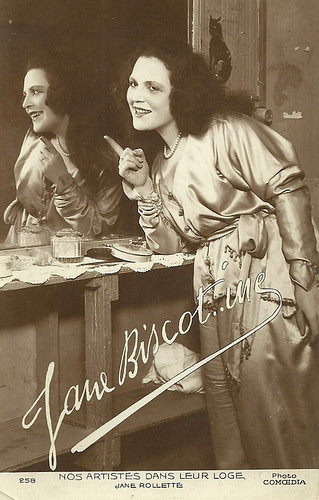
French postcard in the Nos artistes dans leur loges sewries, no. 258. Photo: Comoedia.
The world of circus, vaudeville and fairground
In 1923-1924 Rollette acted in two films with the Italian 'forzuto' Mario Guaita aka Ausonia, Édouard Mathé and Gina Relly . The first is the social drama Mes p'tits/Le calvaire d'un saltimbanque (Paul Barlatier, Charles Keppens, 1923), which evolves in the world of circus, vaudeville and fairground. Rollette is the Amazon who at first eyes Ausonia and later on lifts him up from the gutter and helps him trace his lost children.
The second film is La course à l'amour (Paul Barlatier, Charles Keppens, 1924), a road movie through the French countryside. The story is about a bet between three men ( Ausonia , Édouard Mathé and Léon Lorin) and their search for what they think is one woman. In the second film she helps her mistress ( Gina Relly ) by doubling her to deceive the following men.
Rolette then appeared in the André Deed farce Le nègre du rapide numéro 13 (J. Mandemant, 1923). She closed her film career in 1924 with the serial Les deux gosses by Louis Mercanton, which had rich cast including Carlyle Blackwell, Marjorie Hume , Jean Forest , Gabriel Signoret , Yvette Guilbert and a very young Jean Mercanton, the son of the director. Les Deux Gosses deals with a father (Blackwell) who gives away his son (Mercanton) to evil wandering artists (Signoret, Guilbert) when he unjustly suspects his wife's (Hume) infidelity. When later on he reclaims the child, the evil couple offers him another child (Forest).
Jane Rollette died in Asnières-sur-Seine in 1994.

French postcard by Cinématographes Méric. Postcard for the French silent film Mes p'tits (Paul Barlatier, Charles Keppens, 1923). The girl up right is Jane Rollette, who plays Wanda the amazon, in love with the leading character played by Mario Guaita or Ausonia.
Sources: Cineartistes (French) and .

French postcard by Cinémagazine-Edition, no. 82. Photo: Studio Henri LeBrun.
Serial Queen
Jane (or Jeanne) Rollette was born Jeannette Marie Fontaine in Paris in 1891.
In 1918, Rollette made her film debut opposite Georges Biscot in Louis Feuillade's four-part serial Vendémiaire, which was set during the First World War in the French countryside.
This was the start of an intense career at Gaumont in Feuillade's serial films. She appeared in Ti Minh (1918, 12 episodes), Barrabas (1919, 12 episodes), Les deux gamines/The Two Girls (1920, 12 episodes), L'orpheline (1921, 12 episodes), and Parisette (1921, 12 episodes). In Barrabas Georges Biscot played Biscotin, while Rollette played Biscotine.
Meanwhile Rollette also acted in the serial Le fils de la nuit/The Son of the Night (Gérard Bourgeois, 1919).
Between 1921 and 1923 she played in various comical shorts with Georges Biscot and directed by Feuillade: Zidore ou les métamorphoses, Séraphin ou les jambes nues/Seraphin; or, The Naked Legs, Saturnin ou le bon allumeur, Gustave est médium (all 1921), and Gaëtan ou le commis audacieux (1922).

French postcard in the Nos artistes dans leur loges sewries, no. 258. Photo: Comoedia.
The world of circus, vaudeville and fairground
In 1923-1924 Rollette acted in two films with the Italian 'forzuto' Mario Guaita aka Ausonia, Édouard Mathé and Gina Relly . The first is the social drama Mes p'tits/Le calvaire d'un saltimbanque (Paul Barlatier, Charles Keppens, 1923), which evolves in the world of circus, vaudeville and fairground. Rollette is the Amazon who at first eyes Ausonia and later on lifts him up from the gutter and helps him trace his lost children.
The second film is La course à l'amour (Paul Barlatier, Charles Keppens, 1924), a road movie through the French countryside. The story is about a bet between three men ( Ausonia , Édouard Mathé and Léon Lorin) and their search for what they think is one woman. In the second film she helps her mistress ( Gina Relly ) by doubling her to deceive the following men.
Rolette then appeared in the André Deed farce Le nègre du rapide numéro 13 (J. Mandemant, 1923). She closed her film career in 1924 with the serial Les deux gosses by Louis Mercanton, which had rich cast including Carlyle Blackwell, Marjorie Hume , Jean Forest , Gabriel Signoret , Yvette Guilbert and a very young Jean Mercanton, the son of the director. Les Deux Gosses deals with a father (Blackwell) who gives away his son (Mercanton) to evil wandering artists (Signoret, Guilbert) when he unjustly suspects his wife's (Hume) infidelity. When later on he reclaims the child, the evil couple offers him another child (Forest).
Jane Rollette died in Asnières-sur-Seine in 1994.

French postcard by Cinématographes Méric. Postcard for the French silent film Mes p'tits (Paul Barlatier, Charles Keppens, 1923). The girl up right is Jane Rollette, who plays Wanda the amazon, in love with the leading character played by Mario Guaita or Ausonia.
Sources: Cineartistes (French) and .
Published on February 05, 2017 22:00
February 4, 2017
Imported from the USA: Cyd Charisse
Cyd Charisse (1921-2008) was born to be a dancer. She became one of the top female dancers in the golden era of the musical. Her films include Singin' in the Rain (1952), The Band Wagon (1953), Brigadoon (1954) and Silk Stockings (1957). She was one of the few actresses to have danced with both Fred Astaire and Gene Kelly.
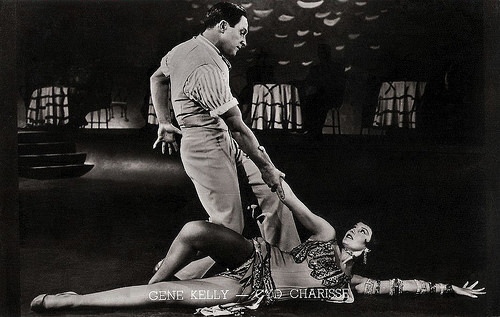
Dutch postcard. Photo: M.G.M. Publicity still for Singin' in the Rain (Stanley Donen, Gene Kelly, 1952) with Gene Kelly.
Ethnic beauties
Cyd Charisse was born Tula Ellice Finklea in 1921 in Amarillo, Texas. Her Baptist jeweler father encouraged her to begin her ballet lessons for health reasons. She was frail and sickly at the time and had a bout with polio.
During a family vacation in Los Angeles when she was 12, her parents enrolled her in ballet classes at a school in Hollywood. One of her teachers was Nico Charisse, whom she married in 1939. She joined the Ballet Russe at age 13 and became a member of the corps de ballet at age 14. With the Ballets Russe, she toured the United States and Europe.
In Paris the company disbanded after World War II broke out, and the Charisse couple moved to Hollywood. She got her start in Hollywood when Ballet Russe star David Lichine was hired by Columbia for a ballet sequence in the musical film Something to Shout About (Gregory Ratoff, 1943). She was billed as Lily Norwood.
The same year, she played a Russian dancer in Mission to Moscow (1943), directed by Michael Curtiz. She took her name Cyd from a nickname originated from her little brother. Initially, he could not say 'sister' and called her 'Sid'. In 1945, she was hired to dance with Fred Astaire in Ziegfeld Follies (Vincente Minelli a.o., 1945), and that uncredited appearance got her a seven-year contract with MGM.
Her first speaking part was supporting Judy Garland in The Harvey Girls (George Sidney, 1946). Her dark looks initially had her cast as ethnic beauties. She was cast as Ricardo Montalban's fiancee in the film Fiesta (Richard Thorpe, 1947), and as a Polynesian in the Esther Williams' musical On an Island with You (Richard Thorpe, 1948).
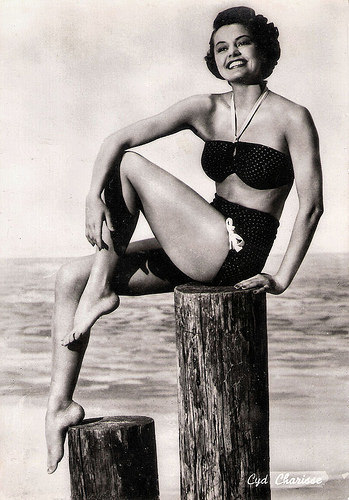
Italian postcard by Bromostampa, Torino/Milano.
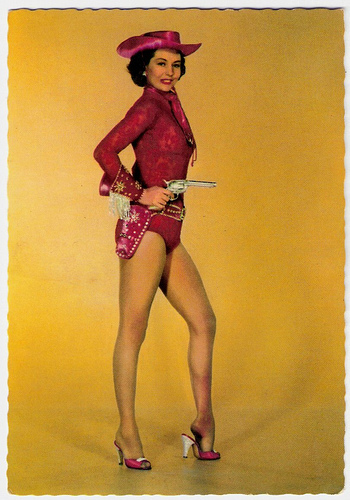
Dutch postcard by P. Moorlag, Heerlen, sort. 1/8.
Dancing in the Dark
Cyd Charisse appeared in a number of musicals over the next few years, but it was the celebrated Broadway Melody ballet finale with Gene Kelly in Singin' in the Rain (Gene Kelly, Stanley Donen, 1952) that made her a star.
That was quickly followed by her great performance in The Band Wagon (Vincente Minnelli, 1953), where she danced with Fred Astaire in the acclaimed Dancing in the Dark number. She co-starred with Kelly in the Scottish-themed musical Brigadoon (Vincente Minnelli, 1954) and in It's Always Fair Weather (Gene Kelly, Stanley Donen, 1956).
In 1957 she rejoined Astaire in the film version of Silk Stockings (Rouben Mamoulian, 1957), a musical remake of Ninotchka (Ernst Lubitsch, 1939), with Charisse taking over Greta Garbo 's role. She had a slightly unusual serious acting role in Party Girl (Nicholas Ray, 1958), where she played a showgirl who became involved with gangsters and a crooked lawyer.
As the 1960s dawned, musicals faded from the screen, as did her career. She made appearances on television and performed in a nightclub revue with her second husband, singer Tony Martin. At 70, she made her Broadway debut in Grand Hotel. Her last film appearance was in That's Entertainment! III (Bud Friedgen, Michael J. Sheridan, 1994) as one of the onscreen narrators of a tribute to the great MGM musical films.
Cyd Charisse died at age 87 of a heart attack in 2008 in Los Angeles, California. She had two sons: Nicholas Charisse (1942) and Tony Martin Jr. (1950).
The Broadway Melody ballet finale from Singin' in the Rain (1952). Source: roquitoyyo (YouTube).
Trailer Silk Stockings (1957). Source: Video Detective (YouTube).
Sources: (IMDb), Wikipedia and .

Dutch postcard. Photo: M.G.M. Publicity still for Singin' in the Rain (Stanley Donen, Gene Kelly, 1952) with Gene Kelly.
Ethnic beauties
Cyd Charisse was born Tula Ellice Finklea in 1921 in Amarillo, Texas. Her Baptist jeweler father encouraged her to begin her ballet lessons for health reasons. She was frail and sickly at the time and had a bout with polio.
During a family vacation in Los Angeles when she was 12, her parents enrolled her in ballet classes at a school in Hollywood. One of her teachers was Nico Charisse, whom she married in 1939. She joined the Ballet Russe at age 13 and became a member of the corps de ballet at age 14. With the Ballets Russe, she toured the United States and Europe.
In Paris the company disbanded after World War II broke out, and the Charisse couple moved to Hollywood. She got her start in Hollywood when Ballet Russe star David Lichine was hired by Columbia for a ballet sequence in the musical film Something to Shout About (Gregory Ratoff, 1943). She was billed as Lily Norwood.
The same year, she played a Russian dancer in Mission to Moscow (1943), directed by Michael Curtiz. She took her name Cyd from a nickname originated from her little brother. Initially, he could not say 'sister' and called her 'Sid'. In 1945, she was hired to dance with Fred Astaire in Ziegfeld Follies (Vincente Minelli a.o., 1945), and that uncredited appearance got her a seven-year contract with MGM.
Her first speaking part was supporting Judy Garland in The Harvey Girls (George Sidney, 1946). Her dark looks initially had her cast as ethnic beauties. She was cast as Ricardo Montalban's fiancee in the film Fiesta (Richard Thorpe, 1947), and as a Polynesian in the Esther Williams' musical On an Island with You (Richard Thorpe, 1948).

Italian postcard by Bromostampa, Torino/Milano.

Dutch postcard by P. Moorlag, Heerlen, sort. 1/8.
Dancing in the Dark
Cyd Charisse appeared in a number of musicals over the next few years, but it was the celebrated Broadway Melody ballet finale with Gene Kelly in Singin' in the Rain (Gene Kelly, Stanley Donen, 1952) that made her a star.
That was quickly followed by her great performance in The Band Wagon (Vincente Minnelli, 1953), where she danced with Fred Astaire in the acclaimed Dancing in the Dark number. She co-starred with Kelly in the Scottish-themed musical Brigadoon (Vincente Minnelli, 1954) and in It's Always Fair Weather (Gene Kelly, Stanley Donen, 1956).
In 1957 she rejoined Astaire in the film version of Silk Stockings (Rouben Mamoulian, 1957), a musical remake of Ninotchka (Ernst Lubitsch, 1939), with Charisse taking over Greta Garbo 's role. She had a slightly unusual serious acting role in Party Girl (Nicholas Ray, 1958), where she played a showgirl who became involved with gangsters and a crooked lawyer.
As the 1960s dawned, musicals faded from the screen, as did her career. She made appearances on television and performed in a nightclub revue with her second husband, singer Tony Martin. At 70, she made her Broadway debut in Grand Hotel. Her last film appearance was in That's Entertainment! III (Bud Friedgen, Michael J. Sheridan, 1994) as one of the onscreen narrators of a tribute to the great MGM musical films.
Cyd Charisse died at age 87 of a heart attack in 2008 in Los Angeles, California. She had two sons: Nicholas Charisse (1942) and Tony Martin Jr. (1950).
The Broadway Melody ballet finale from Singin' in the Rain (1952). Source: roquitoyyo (YouTube).
Trailer Silk Stockings (1957). Source: Video Detective (YouTube).
Sources: (IMDb), Wikipedia and .
Published on February 04, 2017 22:00
February 3, 2017
Rocío Dúrcal
Spanish singer and actress Rocío Dúrcal (1944–2006) was called the ‘Queen of Ranchera’, the traditional Mexican song. She began in the 1950s as a child star and as a teenager, she appeared in a series of popular Spanish 1960s musicals. Later she focused on her musical career, became a star in Mexico and Latin America and won for her albums with rancheras and ballads several Latin Grammy awards.
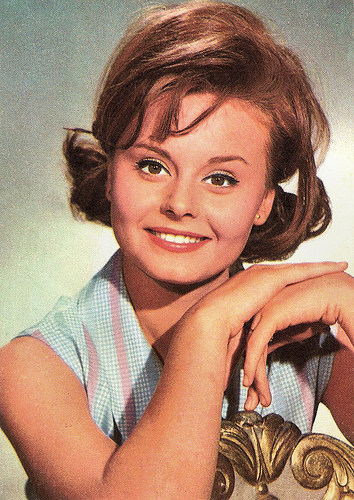
Spanish postcard by Ediciones Tarjefher, no. 214. Photo: Epoca Films.
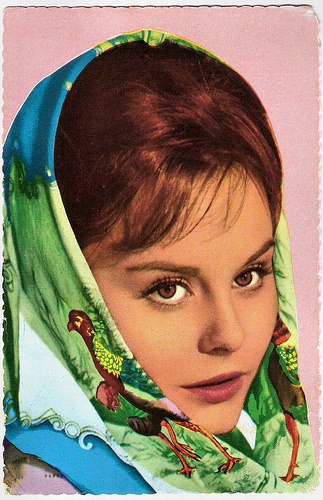
Spanish postcard by Ediciones Tarjefher / Ediciones Mandolina, no. 212. Photo: Epoca Films.
First Applause
Rocío Dúrcal was born María de los Ángeles de las Heras Ortiz in Madrid, Spain, in 1944. She was born and raised in Spain in the bosom of a working-class family. At the age of 10, ‘Marietta’ took part in the radio show, Conozca a sus Vecinos (Meet Your Neighbours). In these shows, she charmed the audience with her clear and melodic voice that also made her a winner in many other radio contests that she participated in those years. She was secretly supported by her paternal grandfather, who believed in her talent and was her first fan.
In 1959, with the approval of her parents, she participated in the television program Primer Aplauso (First Applause). For the contest she sang the traditional song La sombra vendo. Manager Luis Sanz was impressed by her talent and personality and signed her up. Soon after, she started taking singing and dancing lessons with Lola de Aragón and Alberto Lorca. From that time, Maria began working as Rocío Durcal. Durcal is taken from a town in the province of Andalucia in southern Spain.
Her new name was used for the first time in her debut film, the musical Canción de Juventud/Song of Youth (Luis Lucia, 1961). The film was a huge box office hit in Spain and in other Spanish-speaking countries. Soon followed another film vehicle, Rocío de La Mancha (Luis Lucia, 1963) and a record deal with Phonogram (now Universal Music). At this time many other young singer-actors in Spanish films were popular, including Raphael , Marisol , and the twin sisters Pili and Mili .
The songs Dúrcal performed in her films served to make her debut album, Las películas de Rocío Dúrcal (The films of Rocío Dúrcal, 1962). It was the start of a successful recording career. Durcal traveled to Mexico, Venezuela, Puerto Rico and the United States where she appeared on The Ed Sullivan Show.
In her fourth film, Tengo 17 años/I am 17 (José María Forqué, 1964), Dúrcal abandoned the role of child star. That same year, she made her stage debut in Un domingo en Nueva York (A Sunday in New York), in which she proved to be a good theatrical actress. In 1965 she filmed Más bonita que ninguna/Prettier than any (Luis César Amadori, 1965) for which the pop group Los Brincos (considered at the time as the Spanish version of The Beatles ) wrote some songs.
In 1966, she shared the spotlight with Enrique Guzmán in the film Acompáñame/Accompany me (Luis César Amadori, 1966). She began to perform duets with such singers as Jaime Morey and Amalia de Isaura. Then she co-starred in the film Amor en el Aire/Love in Flight (Luis César Amadori, 1967) with Argentine singer-songwriter Palito Ortega and Fernando Rey. The following year, she filmed Cristina Guzmán (Luis César Amadori, 1968), the first of her films that was aimed at an adult audience. She plays the double role of a young widow with a child, whois asked to replace a missing woman, and of course also the missing woman who suddenly returns.
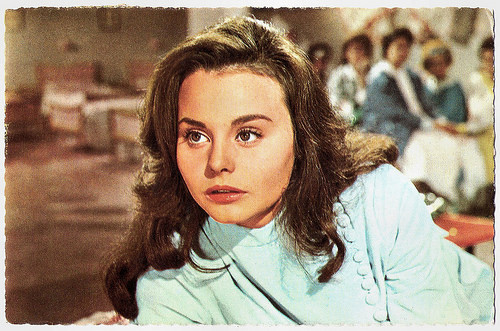
Spanish postcard by Ediciones Tarjefher, no. 206. Photo: Epoca Films / Foto Guzman.
Ranchera
In 1970, Rocío Dúrcal married Philippine musician Antonio Morales, better known as Júnior, a former member of Los Brincos. He would later manage her singing career. In 1972, Morales began a series of television shows in Spain and Latin America singing with his wife as a duo. Their first child, Spanish actress Carmen Morales de las Heras, was born in 1970.
After the birth of their second child, Antonio Morales de las Heras, in 1974, Morales decided to give up his career to devote time to their children. In 1979 they had their third child, Shaila Morales de las Heras, who is now also a singer under the stage name of Shaila Dúrcal.
Dúrcal continued her film and singing career. During the 1970s she appeared in such films as the musical La novicia rebelled/The Rebellious Novice (Luis Lucia, 1971) and the French-Spanish thriller Dites-le avec des fleurs/Say it with flowers (Pierre Grimblat,1974), starring Delphine Seyrig. Her final film was the drama Me siento extraña/I feel strange (Enrique Martí Maqueda, 1977).
In 1977, Dúrcal signed a contract with Ariola Eurodisc, from then on dedicating herself to her musical career. That year, while in Mexico, she met the Mexican singer-songwriter Alberto Aguilera Valadez, better known as Juan Gabriel. He convinced her to perform a popular Mexican style known as ranchera.
They recorded a whole album of rancheras entitled Rocío Dúrcal canta a Juan Gabriel. Backed by the Mexican band, Mariachi América, this resulted in unexpected hits, popularity and awards, not only in Spain and Mexico, but also in Latin America and in the Hispanic community of the United States.
Dúrcal and Juan Gabriel decided to continue to record rancheras together. Dúrcal's album named Canta A Juan Gabriel Volumen 6 (1984) is among the top ten best-selling albums in the history of Mexico. For this album Rocío Dúrcal received her first Grammy Award nomination.
The collaboration of Dúrcal with Juan Gabriel was interrupted by disagreements between the artists and because of problems of Juan Gabriel with his record label, so Dúrcal continued to record albums with other songwriters such as Marco Antonio Solís and Rafael Pérez Botija. She moved from rancheras to romantic ballads. In 1988 she recorded the album Como Tu Mujer with producer Marco Antonio Solis.
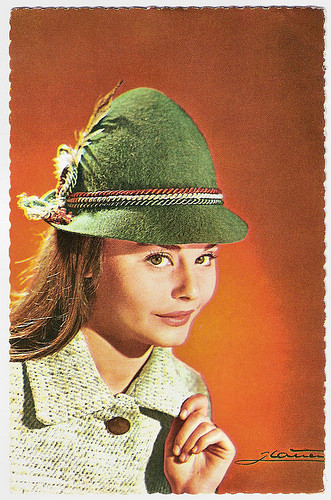
Spanish postcard by Ediciones Tarjefher, no. 201. Photo: Epoca Films / Foto Ibanez.
Uterine cancer
In 1990, Rocío Dúrcal recorded her first album on CD format entitled Si Te Pudiera Mentir. In 1991, Durcal offered a concert at the National Auditorium in Mexico City, recorded in a double disc El Concierto... En Vivo. Between 1992 and 1993 she recorded the album Desaires, produced by the Mexican singer and songwriter Joan Sebastián. In this album she reprises ranchera. With this album, released simultaneously in Mexico, the United States, Colombia, Venezuela and Spain, she made a promotional world tour.
In 1995 she launched her production Hay Amores Y Amores, with songs written and produced by the Argentine Roberto Livi. For this album she was nominated again for a Grammy Award in the category Best Latin Pop Album. In 1997 the double album Juntos Otra Vez brought Rocío Dúrcal and Juan Gabriel together again for the last time. In 1998, under the direction of her discoverer Luis Sanz, she starred in the Spanish TV Show Los negocios de mamá.
In 2000, she celebrated 40 years in the industry. In that year she returned to ranchera music with the album Caricias, under the production of songwriter and producer Bebu Silvetti. In 2001 Rocío Dúrcal recorded Entre Tangos Y Mariachi, again produced by Bebu Silvetti, an album that includes 10 of the most famous Argentine tango arrangements interpreted with ranchero/bolero style like her previous album. In the summer of 2001 Dúrcal made a successful tour in Spain, after 13 years of no shows in Spain.
In 2001 Dúrcal recorded Dama, Dama for Mujer, an album released by BMG Music Spain as part of a campaign to raise funds for an organisation against breast cancer. In 2002, she performed a concert at the National Auditorium in Mexico, which was recorded in the double album En Concierto... Inolvidable. The album was nominated for a Latin Grammy Award.
In 2003, Dúrcal received another Latin Grammy Award nomination for her album Caramelito, produced by Kike Santander. In May 2004 she returned to Spain to record what would be her last album Alma Ranchera, which was nominated for a Latin Grammy Award, but did not win. A year later she received a Latin Grammy Award for musical excellence. Dúrcal had been diagnosed in 2001 with uterine cancer. In 2006, Rocío Dúrcal died at her home in Madrid. She was 61.
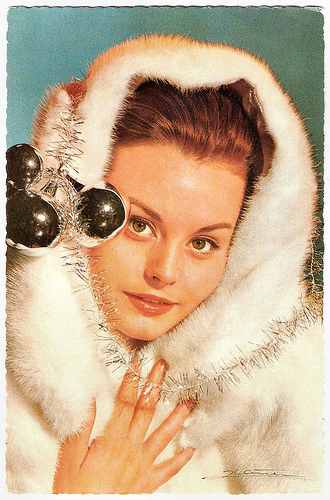
Spanish postcard by Ediciones Tarjet-Fher / Ediciones Mandolina, no. 216. Photo: Epoca Films.
Sources: Drago Bonacich (AllMusic), (IMDb), Wikipedia and .

Spanish postcard by Ediciones Tarjefher, no. 214. Photo: Epoca Films.

Spanish postcard by Ediciones Tarjefher / Ediciones Mandolina, no. 212. Photo: Epoca Films.
First Applause
Rocío Dúrcal was born María de los Ángeles de las Heras Ortiz in Madrid, Spain, in 1944. She was born and raised in Spain in the bosom of a working-class family. At the age of 10, ‘Marietta’ took part in the radio show, Conozca a sus Vecinos (Meet Your Neighbours). In these shows, she charmed the audience with her clear and melodic voice that also made her a winner in many other radio contests that she participated in those years. She was secretly supported by her paternal grandfather, who believed in her talent and was her first fan.
In 1959, with the approval of her parents, she participated in the television program Primer Aplauso (First Applause). For the contest she sang the traditional song La sombra vendo. Manager Luis Sanz was impressed by her talent and personality and signed her up. Soon after, she started taking singing and dancing lessons with Lola de Aragón and Alberto Lorca. From that time, Maria began working as Rocío Durcal. Durcal is taken from a town in the province of Andalucia in southern Spain.
Her new name was used for the first time in her debut film, the musical Canción de Juventud/Song of Youth (Luis Lucia, 1961). The film was a huge box office hit in Spain and in other Spanish-speaking countries. Soon followed another film vehicle, Rocío de La Mancha (Luis Lucia, 1963) and a record deal with Phonogram (now Universal Music). At this time many other young singer-actors in Spanish films were popular, including Raphael , Marisol , and the twin sisters Pili and Mili .
The songs Dúrcal performed in her films served to make her debut album, Las películas de Rocío Dúrcal (The films of Rocío Dúrcal, 1962). It was the start of a successful recording career. Durcal traveled to Mexico, Venezuela, Puerto Rico and the United States where she appeared on The Ed Sullivan Show.
In her fourth film, Tengo 17 años/I am 17 (José María Forqué, 1964), Dúrcal abandoned the role of child star. That same year, she made her stage debut in Un domingo en Nueva York (A Sunday in New York), in which she proved to be a good theatrical actress. In 1965 she filmed Más bonita que ninguna/Prettier than any (Luis César Amadori, 1965) for which the pop group Los Brincos (considered at the time as the Spanish version of The Beatles ) wrote some songs.
In 1966, she shared the spotlight with Enrique Guzmán in the film Acompáñame/Accompany me (Luis César Amadori, 1966). She began to perform duets with such singers as Jaime Morey and Amalia de Isaura. Then she co-starred in the film Amor en el Aire/Love in Flight (Luis César Amadori, 1967) with Argentine singer-songwriter Palito Ortega and Fernando Rey. The following year, she filmed Cristina Guzmán (Luis César Amadori, 1968), the first of her films that was aimed at an adult audience. She plays the double role of a young widow with a child, whois asked to replace a missing woman, and of course also the missing woman who suddenly returns.

Spanish postcard by Ediciones Tarjefher, no. 206. Photo: Epoca Films / Foto Guzman.
Ranchera
In 1970, Rocío Dúrcal married Philippine musician Antonio Morales, better known as Júnior, a former member of Los Brincos. He would later manage her singing career. In 1972, Morales began a series of television shows in Spain and Latin America singing with his wife as a duo. Their first child, Spanish actress Carmen Morales de las Heras, was born in 1970.
After the birth of their second child, Antonio Morales de las Heras, in 1974, Morales decided to give up his career to devote time to their children. In 1979 they had their third child, Shaila Morales de las Heras, who is now also a singer under the stage name of Shaila Dúrcal.
Dúrcal continued her film and singing career. During the 1970s she appeared in such films as the musical La novicia rebelled/The Rebellious Novice (Luis Lucia, 1971) and the French-Spanish thriller Dites-le avec des fleurs/Say it with flowers (Pierre Grimblat,1974), starring Delphine Seyrig. Her final film was the drama Me siento extraña/I feel strange (Enrique Martí Maqueda, 1977).
In 1977, Dúrcal signed a contract with Ariola Eurodisc, from then on dedicating herself to her musical career. That year, while in Mexico, she met the Mexican singer-songwriter Alberto Aguilera Valadez, better known as Juan Gabriel. He convinced her to perform a popular Mexican style known as ranchera.
They recorded a whole album of rancheras entitled Rocío Dúrcal canta a Juan Gabriel. Backed by the Mexican band, Mariachi América, this resulted in unexpected hits, popularity and awards, not only in Spain and Mexico, but also in Latin America and in the Hispanic community of the United States.
Dúrcal and Juan Gabriel decided to continue to record rancheras together. Dúrcal's album named Canta A Juan Gabriel Volumen 6 (1984) is among the top ten best-selling albums in the history of Mexico. For this album Rocío Dúrcal received her first Grammy Award nomination.
The collaboration of Dúrcal with Juan Gabriel was interrupted by disagreements between the artists and because of problems of Juan Gabriel with his record label, so Dúrcal continued to record albums with other songwriters such as Marco Antonio Solís and Rafael Pérez Botija. She moved from rancheras to romantic ballads. In 1988 she recorded the album Como Tu Mujer with producer Marco Antonio Solis.

Spanish postcard by Ediciones Tarjefher, no. 201. Photo: Epoca Films / Foto Ibanez.
Uterine cancer
In 1990, Rocío Dúrcal recorded her first album on CD format entitled Si Te Pudiera Mentir. In 1991, Durcal offered a concert at the National Auditorium in Mexico City, recorded in a double disc El Concierto... En Vivo. Between 1992 and 1993 she recorded the album Desaires, produced by the Mexican singer and songwriter Joan Sebastián. In this album she reprises ranchera. With this album, released simultaneously in Mexico, the United States, Colombia, Venezuela and Spain, she made a promotional world tour.
In 1995 she launched her production Hay Amores Y Amores, with songs written and produced by the Argentine Roberto Livi. For this album she was nominated again for a Grammy Award in the category Best Latin Pop Album. In 1997 the double album Juntos Otra Vez brought Rocío Dúrcal and Juan Gabriel together again for the last time. In 1998, under the direction of her discoverer Luis Sanz, she starred in the Spanish TV Show Los negocios de mamá.
In 2000, she celebrated 40 years in the industry. In that year she returned to ranchera music with the album Caricias, under the production of songwriter and producer Bebu Silvetti. In 2001 Rocío Dúrcal recorded Entre Tangos Y Mariachi, again produced by Bebu Silvetti, an album that includes 10 of the most famous Argentine tango arrangements interpreted with ranchero/bolero style like her previous album. In the summer of 2001 Dúrcal made a successful tour in Spain, after 13 years of no shows in Spain.
In 2001 Dúrcal recorded Dama, Dama for Mujer, an album released by BMG Music Spain as part of a campaign to raise funds for an organisation against breast cancer. In 2002, she performed a concert at the National Auditorium in Mexico, which was recorded in the double album En Concierto... Inolvidable. The album was nominated for a Latin Grammy Award.
In 2003, Dúrcal received another Latin Grammy Award nomination for her album Caramelito, produced by Kike Santander. In May 2004 she returned to Spain to record what would be her last album Alma Ranchera, which was nominated for a Latin Grammy Award, but did not win. A year later she received a Latin Grammy Award for musical excellence. Dúrcal had been diagnosed in 2001 with uterine cancer. In 2006, Rocío Dúrcal died at her home in Madrid. She was 61.

Spanish postcard by Ediciones Tarjet-Fher / Ediciones Mandolina, no. 216. Photo: Epoca Films.
Sources: Drago Bonacich (AllMusic), (IMDb), Wikipedia and .
Published on February 03, 2017 22:00
Paul van Yperen's Blog
- Paul van Yperen's profile
- 13 followers
Paul van Yperen isn't a Goodreads Author
(yet),
but they
do have a blog,
so here are some recent posts imported from
their feed.



